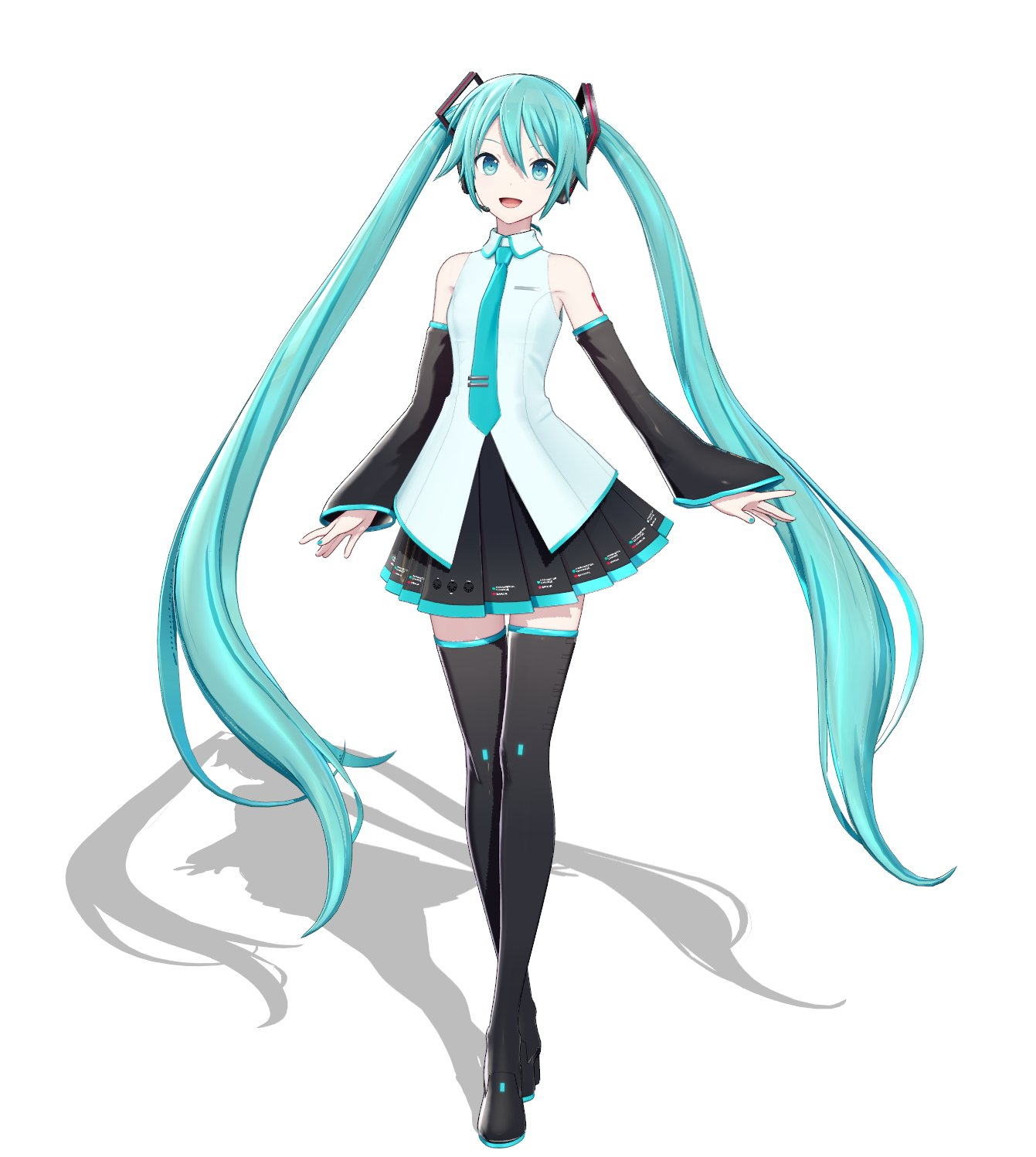Will Otakus Lead us to a Accelerationist Future: Insights from miHoYo’s “Tech Otakus Save the World”
Otakus Will Lead us to a Accelerationist Future:来自 miHoYo 的“Tech Otakus Save the World”的见解
Award-Winning Paper at the International Symposium on ACG Culture 2023. Now Published in the second issue of Creation and Design, 2024.
2023年ACG文化国际研讨会获奖论文。现刊登于2024年第二期《创作与设计》。
Original title: Is Self-Governance of Otaku through Technological Accelerationism Feasible? Insights from miHoYo’s “Tech Otakus Save the World” for Nijigen Design Governance
原标题:通过技术加速主义实现宅男自治是否可行?来自 miHoYo 的“Tech Otakus Save the World”对 Nijigen 设计治理的见解
Author: Zou Qichang, Chen Zhengyang
作者: 徐启昌, 陈正阳
Core Theoretical Contribution of This Paper: It redefines otaku (digital maker) and nijigen (media obsession) from a novel perspective, addressing the legitimacy and future prospects of otaku and nijigen within the framework of an maker society and design governance. The future belongs to otaku and nijigen.
本文的核心理论贡献:从新颖的角度重新定义御宅族(数字创客)和nijigen(媒体痴迷),在创客社会和设计治理的框架内解决御宅族和nijigen的合法性和未来前景。未来属于宅男和nijigen。
Abstract: McLuhan’s “Mechanical Bride” —the interfusion of sex and technology— predicted today’s otaku culture. Otaku and nijigen(the “two‐dimensional” ) represent a technologically accelerated “human-machine romance.” Otaku embody an authentic mode of existence for humanity within the future digital-intelligent civilization; they are the future children born in the wrong era, and thus, otaku culture is inevitably geared towards technological acceleration. Nijigen is both the media environment of the “Mechanical Bride” shaped by Moore’s Law and the rapidly iterating post-human complex in the hearts of otaku. The root of nijigen’s negative externalities lies in the distorted, one-dimensional relationship between humans and technology caused by excessive speed of digital technology progress. Otaku can only overcome technopoly by becoming “Tech Otakus,” establishing a two-dimensional, mutually constructive, and co-evolutionary relationship with the “Mechanical Bride.” MiHoYo has integrated power and capital modules into the “love-driven innovation” model of tech otakus, significantly accelerating the technological development of nijigen media ecology. They use the technological monopolies of nijigen as fuel for technological acceleration, transforming nijigen’s negative externalities into positive ones. The miHoYo model demonstrates that tech otakus might serve as a patch for technological accelerationism because they are inherently equipped with a political agenda that transcends capitalism — production and creation driven by and for love. By returning to their roles as digital makers, otaku can “save themselves” in the process of “saving the world,” thus achieving self-governance of otakus.
Keywords: Tech Otakus; miHoYo; Design Governance; Gongjiang Culture; Theoretical System of Modern Designology in China
Externalities of Nijigen: Starting with an Otaku Entreprise Featured in the People’s Daily
China’s most authoritative newspaper, the People’s Daily’s report on miHoYo, a young Chinese otaku company, can be summarized in one sentence: “Dedicated to technological research and development, exploring frontier technologies, and creating diverse products centered around original IPs, miHoYo has accumulated technical capabilities in areas such as cartoon rendering, artificial intelligence, and cloud gaming technology.”[1] However, despite the slogan “Tech Otakus Save the World” in miHoYo’s brand, their main business is nijigen mobile game development. The two core attributes of miHoYo — “otaku” and “nijigen” — are like the “elephant in the room” in the national narrative. This agenda setting reflects that mainstream society still views “otaku” and “nijigen” as subjects needing governance, especially after miHoYo’s product ecosystem has grown into a renowned “internet super platform” with tens of millions of users, highly popular among young people, and achieved massive commercial success with annual revenues in billions of dollars.
中国最权威的报纸《人民日报》对中国年轻宅男米哈游的报道可以用一句话来概括:“米哈游致力于技术研发,探索前沿技术,围绕原创IP打造多样化产品,在卡通渲染、人工智能、云游戏技术等领域积累了技术能力。[1]然而,尽管miHoYo的品牌口号是“Tech Otakus Save the World”,但他们的主要业务是nijigen手机游戏开发。miHoYo 的两个核心属性——“御宅族”和“nijigen”——就像国家叙事中的“房间里的大象”。这一议程设置反映出主流社会仍然将“御宅族”和“二元”视为需要治理的主体,尤其是在米哈游的产品生态系统成长为拥有数千万用户、深受年轻人欢迎、年收入达数十亿美元的巨大商业成功之后。
If we consider otaku and nijigen as a new type of human-machine relationship in the era of digital makers, then “otaku governance” and “nijigen governance” share the same essence — the governance of the externalities of the nijigen media environment. Otaku represent the externalities of nijigen, as McLuhan noted, media create the public[2]. Nijigen media belong to the machine system, thus their governance can be seen as the governance of human-machine relationships.
如果我们把御宅族和nijigen看作是数字制造者时代的一种新型的人机关系,那么“御宅族治理”和“nijigen治理”有着相同的本质——对nijigen媒体环境外部性的治理。宅男代表了 nijigen 的外部性,正如麦克卢汉所指出的,媒体创造了公众[2]。Nijigen媒体属于机器系统,因此它们的治理可以看作是人机关系的治理。
Nijigen is an artifact system, envisioned and created by humans, embodying the intent to transform the world and build a better society, so Nijigen governance also falls under design governance. Design governance is one of the core categories of social designology, focusing on the social effects that overflow from artifacts. These effects usually include both positive and negative impacts. For example, Putnam pointed out that the widespread use of television led to a decline in overall social capital in the United States[3], an unintended consequence of the television’s designers, making it a design governance issue.
Nijigen是一个人工系统,由人类设想和创造,体现了改造世界和建设更美好社会的意图,因此Nijigen治理也属于设计治理。设计治理是社会设计学的核心范畴之一,关注从人工制品中溢出的社会效应。这些影响通常包括积极和消极的影响。例如,普特南指出,电视的广泛使用导致了美国整体社会资本的下降[3],这是电视设计者的意外后果,使其成为一个设计治理问题。
Otaku culture originated in Japan during the semiconductor boom of the 1980s and rose alongside new digital media represented by personal computers. In the early 21st century, otaku culture took root in China, coinciding with the rise of new digital media, exemplified by internet streaming platforms like Bilibili. Today, the media technology breakthroughs brought by miHoYo signify that otaku culture will reach new heights within the reach of miHoYo’s products.
御宅族文化起源于 1980 年代半导体繁荣时期的日本,并与以个人电脑为代表的新数字媒体一起兴起。21世纪初,御宅族文化在中国扎根,恰逢新数字媒体的兴起,以哔哩哔哩等互联网流媒体平台为例。今天,米哈游带来的媒体技术突破,意味着御宅族文化将在米哈游产品触手可及的范围内达到新的高度。
早期日本宅男对人形计算机的幻想(图片来源:https://www.crunchyroll.com/series/G9VHN97K8/chobits)
Unlike Generation Z, Otaku are notorious, a group initially perceived as full of negative externalities. The term “otaku” has long been synonymous with “hikikomori” (shut-ins), “parasite singles,” “socially awkward,” and “addicted youth,” clashing with the work ethic of capitalism. The 1989 Miyazaki Tsutomu incident in Japan cemented the image of otakus as “potential criminals” in the public eye. It wasn’t until the new millennium, when the Japanese government sought to revitalize the economy and reshape cultural soft power through the “Cool Japan” strategy, that the positive externalities of otaku were finally recognized.
与Z世代不同,宅男是臭名昭著的,这个群体最初被认为充满了负面的外部性。长期以来,“宅男”一词一直是“彦森”、“寄生单身”、“社交尴尬”和“上瘾青年”的代名词,与资本主义的职业道德相冲突。1989年日本宫崎骏事件巩固了宅男在公众眼中作为“潜在罪犯”的形象。直到新千年,日本政府试图通过“酷日本”战略来振兴经济和重塑文化软实力,御宅族的正外部性才最终得到认可。
In a similar vein, the People’s Daily highlighted the positive externalities of miHoYo’s products, such as “showcasing the charm of Chinese culture,” “sparking young people’s enthusiasm for traditional culture,” and “winning a better future through technological innovation”[4]. However, these praises were framed separately from the otaku and nijigen culture. Nijigen design governance aims to reduce and eliminate the negative externalities of nijigen while guiding and nurturing its positive externalities. In stark contrast to the long-subsidized yet not-so-successful Chinese animation industry, nijigen at miHoYo has flourished unexpectedly — contributing not only to the GDP but also generating positive externalities that have captured national attention. The miHoYo issue has thus become a pivotal topic in the current study of nijigen design governance.
同样,《人民日报》也强调了米哈游产品的积极外部性,如“展示中国文化的魅力”、“激发年轻人对传统文化的热情”、“通过技术创新赢得更美好的未来”[4]。然而,这些赞美是与御宅族和nijigen文化分开构建的。Nijigen设计治理旨在减少和消除Nijigen的负外部性,同时引导和培育其正外部性。与长期补贴但不太成功的中国动漫产业形成鲜明对比的是,米哈游的nijigen出乎意料地蓬勃发展——不仅为GDP做出了贡献,还产生了积极的外部效应,引起了全国的关注。因此,miHoYo问题成为当前nijigen设计治理研究的一个关键话题。
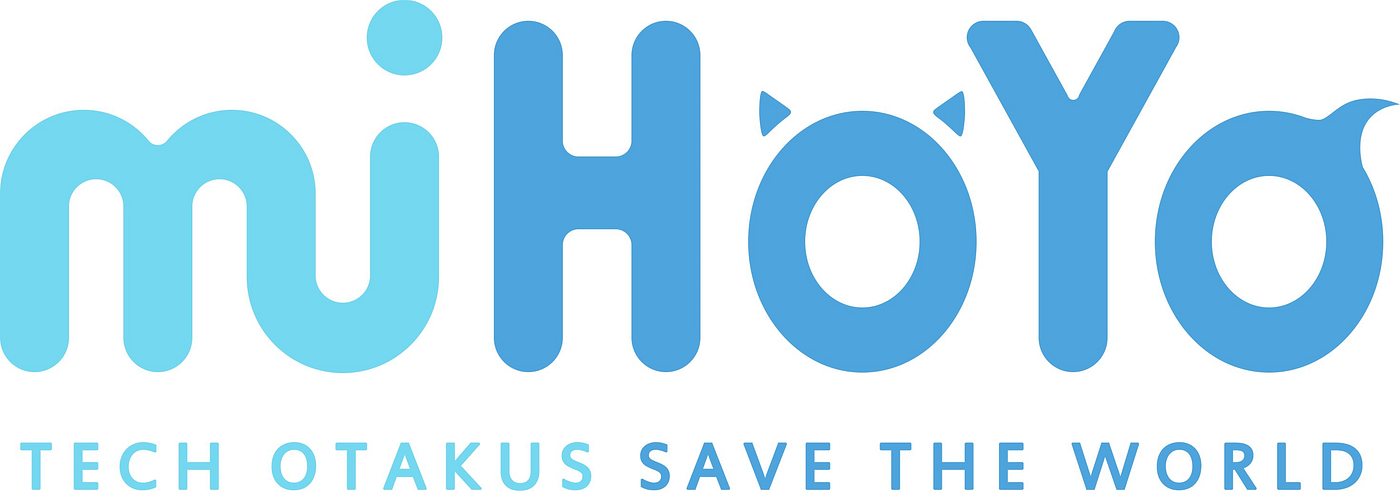
miHoYo 的合作伙伴身份
The first part of miHoYo’s slogan, “Tech Otakus,” highlights that technological issues are central to otaku problems. On one hand, as Huxley’s “Brave New World” inspired Postman’s “Amusing Ourselves to Death” [5], the root of nijigen’s negative externalities lies in technolopy. On the other hand, technology and design are two sides of the same coin. Since humans are the creators of technology, the solution must come from the creators themselves. MiHoYo has demonstrated that tech otakus, as the designer otakus, have the potential to dismantle nijigen media’s technolopy, thereby mitigating its negative externalities. The ideal form of nijigen design governance is, therefore, self-governance by the otakus.
miHoYo 口号的第一部分“Tech Otakus”强调了技术问题是宅男问题的核心。一方面,正如赫胥黎的《美丽新世界》启发了邮差的《自娱自乐至死》[5]一样,尼吉根的负外部性的根源在于技术性。另一方面,技术和设计是同一枚硬币的两面。由于人类是技术的创造者,因此解决方案必须来自创造者自己。米哈游已经证明,科技宅男作为设计师宅男,有可能瓦解nijigen媒体的技术性,从而减轻其负面外部性。因此,nijigen设计治理的理想形式是宅男的自治。
The latter part of the slogan, “Save the World,” showcases a significant difference in cultural context and mindset between Chinese otaku and their Japanese counterparts. Unlike the Japanese otakus depicted in the late 20th century by “Neon Genesis Evangelion,” who retreated into their inner worlds, Chinese otakus, represented by miHoYo’s founders, confidently proclaim their intent to change the outer world. Their tech otaku model, driven by love and combined with modern corporate institutions, has unleashed tremendous positive energy, resonating with the current theme of high-quality development.
口号的后半部分,“拯救世界”,展示了中国御宅族与日本御宅族在文化背景和思维方式上的显着差异。与20世纪末《新世纪福音战士》中描绘的日本御宅族不同,他们退缩到自己的内心世界,以米哈游创始人为代表的中国御宅族自信地宣称他们打算改变外部世界。他们的科技御宅族模式,以爱为动力,结合现代企业机构,释放出巨大的正能量,与当前高质量发展的主题产生共鸣。
This paper aims to propose and explore the miHoYo issue, which involves a new innovation model and its components, making it a matter of constructing a new innovation system for tomorrow. It concerns how digital makers (tech otakus) can regulate the negative externalities of nijigen and release its positive externalities, thereby addressing the problem of building a future new-makers society for humanity[6]. It depends on the attitudes and actions of otaku youth towards technology, making it a timely issue that otaku youth face amidst a new wave of technological advancement and social change.
本文旨在提出和探讨米哈游问题,该问题涉及一种新的创新模式及其组成部分,使其成为构建面向未来的新创新体系的问题。它涉及数字创客(科技宅男)如何调节nijigen的负外部性并释放其正外部性,从而解决为人类构建未来新创客社会的问题[6]。这取决于御宅族青年对技术的态度和行动,使其成为御宅族青年在新一轮技术进步和社会变革中面临的及时问题。
Otaku and Nijigen: The Rapidly Iterating “Human-Machine Romance”
宅男和二元:快速迭代的“人机恋情”
Before delving into the externalities of nijigen, it is essential to define otaku and nijigen.
在深入研究 nijigen 的外部性之前,必须定义宅男和 nijigen。
Research on otaku and nijigen originated in Japan. In 1983, Akio Nakamori first attempted to define otaku: “They are obsessed with something to the extent that they do not wish to interact with other people in society” [7]. This obsessive nature is a common characteristic of otaku. Eiji Ōtsuka, who proposed the theory of narrative consumption, believed that otaku’s object of obsession is the fictional world, or the so-called “imaginary reality.” He pointed out that the mode of imagination where “the fictional world is formed within the same structure as the real world” is the essential feature of otaku [8]. Toru Honda argued that otaku are not obsessed with the fictional world as a “stage,” but rather with the fictional characters on that “stage.” He defined otaku by their unique view of romance — “moe.” “Moe” is the infatuation with fictional characters projected by Nijigen media into the minds of otaku, representing a form of romance that transcends materialism and his so called “romance capitalism.”
关于御宅族和nijigen的研究起源于日本。1983年,中森昭夫(Akio Nakamori)首次尝试定义御宅族:“他们痴迷于某事,以至于他们不希望与社会中的其他人互动”[7]。这种强迫症是宅男的共同特征。提出叙事消费理论的大冢英二认为,御宅族痴迷的对象是虚构的世界,或者说是所谓的“虚构的现实”。他指出,“虚构世界在与现实世界相同的结构中形成”的想象模式是御宅族的本质特征[8]。本田彻认为,宅男并不痴迷于作为“舞台”的虚构世界,而是痴迷于“舞台”上的虚构人物。他用他们独特的浪漫观来定义御宅族——“萌”。“萌”是Nijigen媒体投射到宅男脑海中的对虚构人物的迷恋,代表了一种超越物质主义和他所谓的“浪漫资本主义”的浪漫形式。
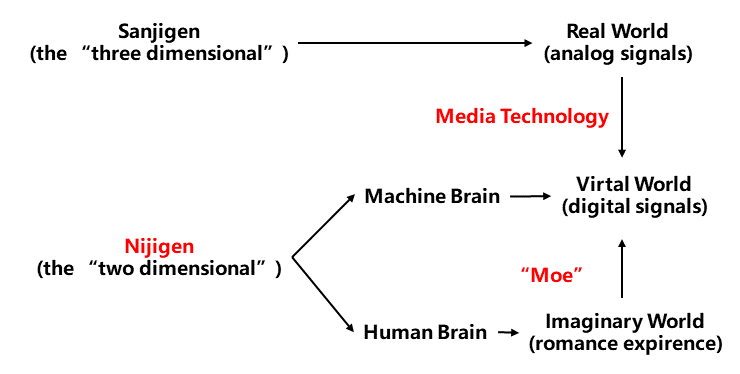
宅男的控制论浪漫模式。
From the perspective of information theory, love is fundamentally the exchange of information in the brain. As visual, auditory, tactile, and other multimodal signals are progressively digitized and simulated by machines, love, when reduced to digital signals, achieves freedom and equality, as described by otakus through their concept of “moe” romance[9]. Honda Tooru still confines “moe” within the minds of otaku, but his signalism view of love reminds us that romance signals can originate from human brains as well as from machine brains. Thus, a form of love where signals are exchanged between human brains and machine brains signifies a new type of human-machine relationship, which constitutes the essence of otaku and nijigen culture.
从信息论的角度来看,爱从根本上说是大脑中信息的交换。随着视觉、听觉、触觉和其他多模态信号逐渐被机器数字化和模拟,当爱情被简化为数字信号时,就会实现自由和平等,正如宅男通过他们的“萌”浪漫概念所描述的那样[9]。Honda Tooru 仍然将“萌”限制在宅男的脑海中,但他的爱情信号主义观点提醒我们,浪漫信号可以来自人类的大脑,也可以来自机器的大脑。因此,人脑和机器大脑之间交换信号的一种爱的形式意味着一种新型的人机关系,它构成了御宅族和二次文化的本质。
Noticed any very spare parts lately?
最近注意到任何非常备件吗?
Have you got what it takes to hook a date?
你有勾搭约会的能力吗?
See us for the highest bid on your old model.
请与我们联系,了解您的旧型号的最高出价。
“The walk,” “the legs,” “the body,” “the hips,” “the look,” “the lips,”
“走路”、“腿”、“身体”、“臀部”、“表情”、“嘴唇”、
Did she fall off a wall? Call all the king’s horses and men. [10]
她是从墙上掉下来的吗?召唤所有国王的马匹和人。[10]
As early as 1951, Marshall McLuhan prophesied today’s otaku culture and nijigen in his satirical advertising literature. He humorously summarized the impact of post-industrial-revolution modern media, including its new technologies and materials, on human sexual orientation as the “love goddess assembly line” and “the mechanical bride”:
早在1951年,马歇尔·麦克卢汉(Marshall McLuhan)就在他的讽刺广告文学中预言了今天的御宅族文化和nijigen。他幽默地总结了后工业革命时代的现代媒体,包括其新技术和新材料,作为“爱情女神流水线”和“机械新娘”对人类性取向的影响:
These two ads help us to see one of the most peculiar features of our world — the interfusion of sex and technology. It is not a feature created by the ad men, but it seems rather to be born of a hungry curiosity to explore and enlarge the domain of sex by mechanical technique, on one hand, and, on the other, to possess machines in a sexually gratifying way. [11]
这两则广告帮助我们看到我们这个世界最奇特的特征之一——性与技术的融合。它不是广告人创造的特征,但它似乎源于一种饥饿的好奇心,一方面通过机械技术探索和扩大性领域,另一方面以性满足的方式拥有机器。[11]
McLuhan’s media ecology suggests that “human-machine love” is not a distant future fantasy from science fiction, but has already spread in industrial society with the emergence of new media. Since machines can amplify human strength and intelligence, it’s not surprising that they also amplify human charm and desire. Today’s nijigen industry can be seen as a digitized “love goddess assembly line,” and the “paper-thin mai waifu” ¹ in otaku culture is akin to the “mechanical bride” born from various nijigen media.
麦克卢汉的媒体生态学表明,“人机之爱”并不是科幻小说中遥远的未来幻想,而是随着新媒体的出现,已经在工业社会中传播开来。由于机器可以放大人类的力量和智慧,因此它们也可以放大人类的魅力和欲望也就不足为奇了。如今的nijigen行业可以看作是数字化的“爱情女神流水线”,宅男文化中的“薄如纸的mai waifu”¹类似于从各种nijigen媒体中诞生的“机械新娘”。
[¹ Otakus’ playful term to avoid censorship for their virtual romance for fictional characters across various media, with variants for different genders.]
[¹ Otakus 的俏皮术语,以避免对各种媒体上虚构人物的虚拟浪漫进行审查,并针对不同性别。
The nijigen media environment forms the material basis for fictional characters’ existence. With the advancement of media technology, it has evolved from comics to animation and then to games, transitioning from analog to digital media. Although new media at different stages have not completely replaced old media, they often dominate the mainstream and incorporate the technological systems of older media, such as games encompassing the technological systems of illustration, comics, films, animation, music, and more.
nijigen媒体环境构成了虚构人物存在的物质基础。随着媒体技术的进步,它已经从漫画发展到动画,然后发展到游戏,从模拟媒体过渡到数字媒体。虽然不同阶段的新媒体并没有完全取代旧媒体,但它们往往占据主流,并融合了旧媒体的技术体系,例如游戏,包括插画、漫画、电影、动画、音乐等技术体系。
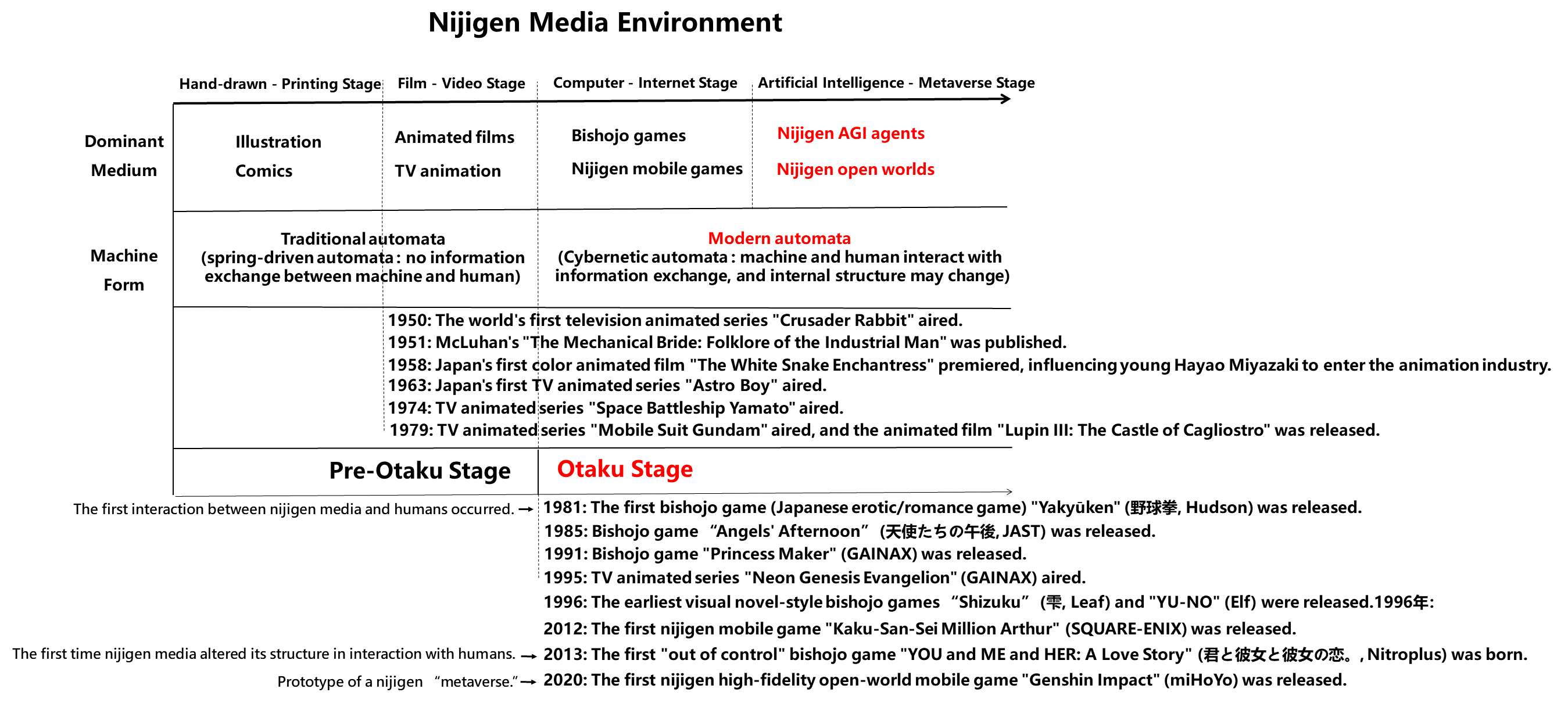
So far, there have been two key historical milestones in the evolution of the nijigen media environment:
到目前为止,nijigen媒体环境的演变有两个关键的历史里程碑:
The first was in the 1950s, with the establishment of the film-television animation system dominated by analog media technologies. The traditional automata structure-based “mechanical bride” transitioned towards electrification.
第一次是在 1950 年代,建立了以模拟媒体技术为主导的电影电视动画系统。传统的基于自动机结构的“机械新娘”向电气化过渡。
The second was in the 1980s, with the emergence of the electronic gaming system dominated by digital media technologies. The “mechanical bride” evolved towards a cybernetic virtual machine.
第二次是在 1980 年代,随着以数字媒体技术为主导的电子游戏系统的出现。“机械新娘”演变成控制论虚拟机。
It is foreseeable that the nijigen will soon evolve into more advanced forms incorporating artificial intelligence and the metaverse. In the distant future era of strong artificial intelligence, “human-machine love” may become commonplace. As McLuhan once said:
可以预见,nijigen将很快演变成更先进的形式,包括人工智能和元宇宙。在人工智能强势的遥远未来时代,“人机之爱”或许会变得司空见惯。正如麦克卢汉曾经说过的那样:
there is more obvious truth in the way in which sex has been exaggerated by getting hooked to the mechanisms of the market and the impersonal teclmiques of industrial production.
更明显的事实是,性被迷上了市场机制和工业生产的非人性技术而夸大了。……In the era of thinking machines, it would be surprising, indeed, if the love-machine were not thought of as well. [12]
……在思考机器的时代,如果爱情机器没有被考虑在内,那将是令人惊讶的。[12]
So far, there have been two key historical milestones in the evolution of the nijigen media environment:
到目前为止,nijigen媒体环境的演变有两个关键的历史里程碑:
We can consider that otaku culture emerged during the dawn of the digital revolution, mainly for the following two reasons:
我们可以认为御宅族文化是在数字革命的黎明中出现的,主要有以下两个原因:
(1)Otaku culture is defined by its unique media obsession— nijigen obsession, an obsession with fictional characters across a two-dimensional interface², such as a piece of paper or a screen. This obsession began to emerge during the rise of animated media, such as Osamu Tezuka’s “animation-is-erotic” and Hayao Miyazaki’s “imaginary girl in a boy’s mind”[13], but had not yet spread widely in society. Fictional characters evolved alongside media technology development, and until the “lucidity” of media reached a certain threshold, it was difficult for people to develop a media obsession. However, unlike the analog media of the industrial age, digital media technology develops according to Moore’s Law, and the “charm” of virtual characters grows exponentially. For example, while an 8-bit color-coded system can only display virtual characters in 256 colors, a 32-bit color-coded system supports nearly 4.29 billion colors. The accelerated evolution of virtual characters on digital media facilitated the spread of media fixation, gradually establishing otaku culture as a significant cultural phenomenon after the 1980s.
(1)御宅族文化的定义是其独特的媒体痴迷——nijigen痴迷,即对二维界面²(如一张纸或屏幕)上的虚构人物的痴迷。这种痴迷在动画媒体兴起期间开始出现,例如手冢治虫的“动画是色情的”和宫崎骏的“男孩脑海中的想象中的女孩”[13],但尚未在社会上广泛传播。虚构人物随着媒体技术的发展而发展,在媒体的“清醒”达到一定门槛之前,人们很难发展出对媒体的痴迷。然而,与工业时代的模拟媒体不同,数字媒体技术是按照摩尔定律发展起来的,虚拟角色的“魅力”呈指数级增长。例如,8 位颜色编码系统只能显示 256 种颜色的虚拟字符,而 32 位颜色编码系统支持近 42.9 亿种颜色。数字媒体上虚拟角色的加速发展促进了媒体固定的传播,在1980年代后逐渐将御宅族文化确立为一种重要的文化现象。
[²Nijigen, the two-dimensional, is metaphorical here, as in the future the interface for interacting with fictional characters will not necessarily be a two-dimensional screen.]
[²二维的Nijigen在这里是隐喻的,因为未来与虚构人物互动的界面不一定是二维屏幕。
(2)At this historical juncture, otaku culture created a brand-new nijigen medium. Originating from Akihabara, Tokyo’s electronics district, the first generation of tech otakus created “love machines” — bishojo games, laying the foundation for today’s nijigen mobile games and predecessor of future nijigen AGI agent. Initially, otaku emerged on the historical stage as digital makers.
(2)在这个历史关头,御宅族文化创造了一种全新的nijigen媒介。起源于东京电子区秋叶原的第一代科技宅男创造了“爱情机器”——美少女游戏,为今天的 nijigen 手机游戏奠定了基础,也是未来 nijigen AGI 代理的前身。最初,宅男作为数字制造商出现在历史舞台上。
The otaku culture embodies the faith of “I love, therefore I am,” where their love represents a post-human affection directed towards machines. This love emerged during the rapid iterations of media technology in the digital age, where technological acceleration tightly binds otaku romance with dopamine mechanisms. Dopamine is a neurotransmitter produced in the human brain’s neocortex, primarily responsible for reward anticipation errors and extrapersonal spatial behavior [14]. These two “biological algorithms” foster human curiosity and novelty-seeking behaviors, and also enable humans to enjoy imagination and plan for the future.
御宅族文化体现了“我爱,所以我是”的信仰,他们的爱代表了一种针对机器的后人类情感。这种爱出现在数字时代媒体技术的快速迭代中,技术加速将宅男的浪漫与多巴胺机制紧密联系在一起。多巴胺是人脑新皮层产生的一种神经递质,主要负责奖励预期错误和个人外空间行为[14]。这两种“生物算法”培养了人类的好奇心和寻求新奇的行为,也使人类能够享受想象力和规划未来。
The concept of “database consumption” coined by Hiroki Azuma [15] echoes the underlying neuroscientific logic of otaku love: they break down old fictional characters into individual character elements, creating a database of character designs. By simply selecting and rearranging these elements from the database, they can generate “new” fictional characters through a process of “parts replacement”. In this way, otaku’s character consumption can perpetuate endlessly.
Hiroki Azuma[15]创造的“数据库消费”概念呼应了宅男爱情的潜在神经科学逻辑:他们将旧的虚构角色分解为单独的角色元素,创建一个角色设计数据库。通过简单地从数据库中选择和重新排列这些元素,他们可以通过“零件更换”过程生成“新的”虚构角色。这样一来,宅男的性格消耗就可以无休止地持续下去。
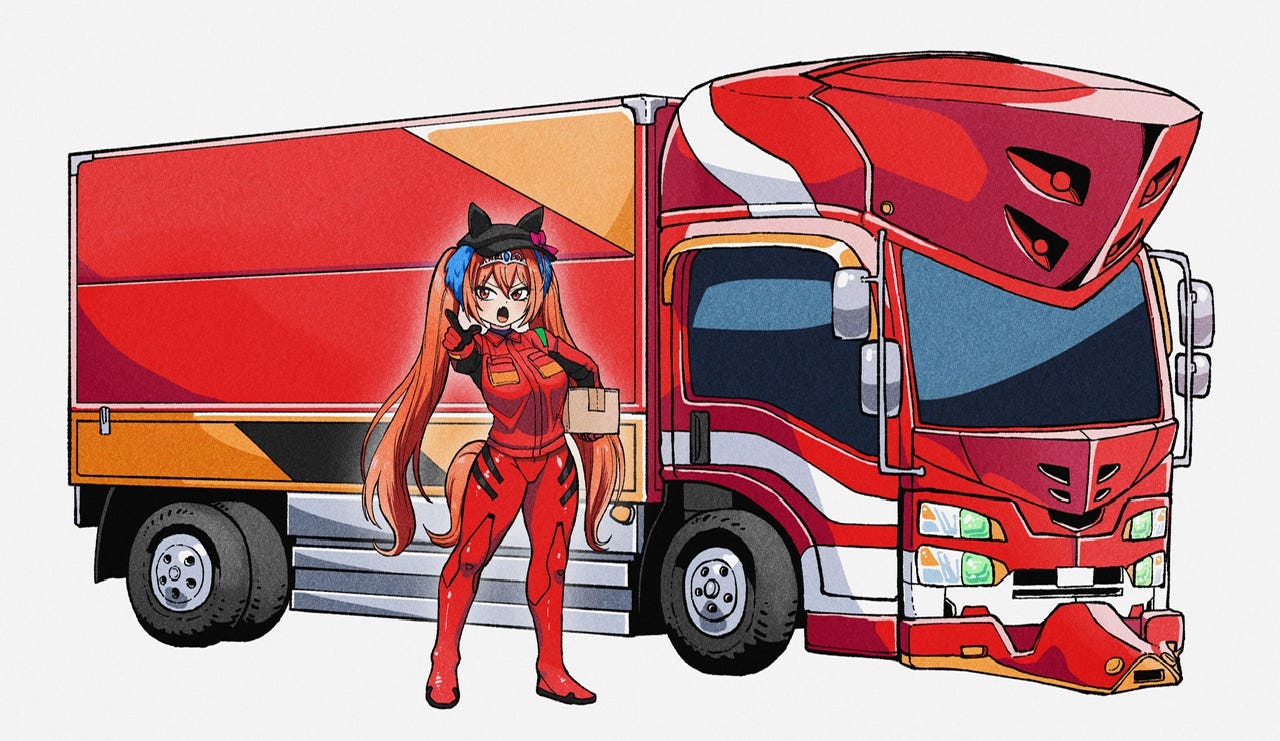
明日香是《新世纪福音战士》中的主角之一,是一个留着双马尾辫的好胜傲娇女孩,穿着红色战斗服。由于她的名字在语音上相似,《Uma Musume Pretty Derby》的设计师特意从明日香身上提取了各种角色元素,并将它们与赛马元素相结合,创造了一个新角色,Daiwa Scarlet(Dasuka)。通过这种方式,宅男通过数据库消费通过赤城大和延续了他们对明日香的爱(图片来源:https://www.pixiv.net/artworks/110752126)。
Otaku often find it challenging to be content with the old or the present; they perpetually seek new thrills and envision a future where anything is possible. Beyond database consumption, their dopamine-driven emotional patterns perfectly align with the evolution of virtual machines according to Moore’s Law. For living humans in the “sanjigen” (three-dimensional world) , their body is an indivisible organic continuum. However, for virtual characters in the “nijigen” (two-dimensional world), based purely on artificial signals, components such as “the legs,” “the hips,” “the lips,” “the twin tails,” “the miniskirts,” and even voices, personalities, and identities, are all detachable, assemblable, and replaceable parts or modules. These components come in an almost infinite variety of models, with the media technology that simulates them continuously evolving. We might imitate McLuhan and craft an advertisement for Hatsune Miku, a quintessential “mechanical bride” in the digital era:
宅男经常发现满足于旧或现在具有挑战性;他们不断寻求新的刺激,并设想一个一切皆有可能的未来。除了数据库消费之外,根据摩尔定律,他们的多巴胺驱动的情绪模式与虚拟机的进化完全一致。对于“三维世界”中的活生生的人类来说,他们的身体是一个不可分割的有机连续体。然而,对于纯粹基于人工信号的“二维世界”中的虚拟角色来说,“腿”、“臀部”、“嘴唇”、“双尾巴”、“迷你裙”等组件,甚至声音、个性和身份,都是可拆卸、可组装、可更换的部件或模块。这些组件的模型种类繁多,模拟它们的媒体技术也在不断发展。我们可以模仿麦克卢汉,为初音未来制作一则广告,初音未来是数字时代典型的“机械新娘”:
By simply upgrading to the latest and most popular parts and refreshing her internal system, she can perpetually retain her idol allure. Her ‘soul’ can transcend her ‘shell,’ transforming into myriad beautiful forms, becoming an eternal dopamine machine.
只需升级到最新、最受欢迎的部分,刷新自己的内部系统,她就可以永远保持偶像的魅力。她的“灵魂”可以超越她的“外壳”,变成无数美丽的形式,成为永恒的多巴胺机器。
就像通用汽车从 1920 年代到 1950 年代的“计划报废”战略一样,初音未来的官方赛车主题图像(初音未来 GT 项目)每年都会更新(图片来源:https://www.goodsmileracing.com/15th/)。
In contrast to real-world relationships with living people, otaku’s inclination towards “mechanical brides” is not without justification; it may indeed reflect a trend in future AGI society. It could be argued that otaku represent a genuine human survival mode within the emerging digital intelligent civilization, embodying futuristic individuals born in the wrong era. Therefore, otaku culture inevitably gravitates towards technological acceleration and finds its way back to the future.
与现实世界中与活人的关系相比,宅男对“机械新娘”的倾向并非没有道理;它可能确实反映了未来AGI社会的趋势。可以说,御宅族代表了新兴数字智能文明中真正的人类生存模式,体现了出生在错误时代的未来主义个体。因此,御宅族文化不可避免地倾向于技术加速,并找到了回到未来的方式。
The love of otaku is a dopamine-driven infatuation pattern, emblematic of a media obsession under an exponential growth paradigm, giving rise to the consumption model of “database” that drives the rapid iteration of “mechanical brides.” However, rapid iteration of “mechanical brides” through mere component updates or rearrangements is not-so-sufficient; they also require fundamental “architectural” and “systematic” upgrades. Stemming from a technological foundation, the emergence of tech otakus who handcraft and upgrade the base of “mechanical brides,” thereby revolutionizing the world of nijigen media environments, epitomizes an technological innovation model fueled by love.
宅男的爱是一种多巴胺驱动的迷恋模式,象征着指数增长范式下的媒体痴迷,催生了推动“机械新娘”快速迭代的“数据库”消费模式。然而,仅仅通过组件更新或重新排列来快速迭代“机械新娘”是不够的;它们还需要基本的“架构”和“系统”升级。源于技术基础,手工制作和升级“机械新娘”基础的科技宅男的出现,从而彻底改变了 nijigen 媒体环境的世界,是以爱为动力的技术创新模式的缩影。
The Roots of Nijigen Negative Externalities: Technopoly
Nijigen负外部性的根源:技术垄断
Tech otaku culture originated in the 1980s in Akihabara, Japan’s electronics district, but it truly flourished during the mobile communications era within China’s internet industry. In 2010, the world’s first 4G network was launched, and Apple released the iPhone 4. The following year, miHoYo was founded. During the golden decade of China’s internet industry, miHoYo emerged as a leading company in the nijigen market, symbolizing independent innovation and international influence. Remarkably, even in Japan, the birthplace of otaku culture, few otaku enterprises match miHoYo’s level of technological innovation. MiHoYo’s products and brand silently proclaim: “Otaku can also represent advanced productive force.”
科技御宅族文化起源于 1980 年代的日本电子区秋叶原,但它真正蓬勃发展的是中国互联网行业的移动通信时代。2010年,全球首个4G网络推出,苹果发布了iPhone 4。次年,米哈游成立。在中国互联网产业的黄金十年中,米哈游成为nijigen市场的龙头企业,象征着自主创新和国际影响力。值得注意的是,即使在御宅族文化的发源地日本,也很少有御宅族企业能与米哈游的技术创新水平相媲美。米哈游的产品和品牌默默宣告:“宅男也可以代表先进的生产力。
However, miHoYo’s growth period (2011–2021) also marked a decade during which the nijigen environment moved towards technology monopoly (as termed coined by Postman, “technopoly” which means technology supplanted human factors as the primary, if not the sole, criterion of value assessment. In Postman’s word, culture surrender to tehchnology) [16].
然而,miHoYo 的增长期(2011-2021 年)也标志着 nijigen 环境走向技术垄断的十年(正如 Postman 创造的那样,“技术垄断”意味着技术取代了人为因素,成为价值评估的主要标准。用波斯特曼的话来说,文化屈服于技术学)[16]。
The nijigen mobile games, built upon the technology of smart mobile devices, became the mainstream medium in the nijigen media environment. In this “screen era,” where smartphones are ubiquitous, the disciplining and controlling influence of nijigen media on audiences, along with its negative externalities (such as addiction, repetitive game labor, and irrational consumption), have reached unprecedented levels.
建立在智能移动设备技术基础上的nijigen手机游戏成为nijigen媒体环境中的主流媒体。在这个智能手机无处不在的“屏幕时代”,nijigen媒体对受众的规训和控制影响,以及其负面外部性(如成瘾、重复性游戏劳动和非理性消费)达到了前所未有的水平。
In 2012, the first nijigen mobile game, “KSS Million Arthur” (拡散性ミリオンアーサー), began operations in Japan. By 2020, the globally acclaimed Chinese nijigen mobile game “Genshin Impact” not only marked a significant milestone in the narrative of “Tech otakus save the world,” but also became a watershed moment for the technopoly in the nijigen ecology. Before exploring the tech-otaku model and its derivative, the miHoYo model, it is essential to understand the critical background of miHoYo’s rise — how technopoly within the mobile gaming system has introduced and amplified the negative externalities of nijigen [17].
2012年,第一款nijigen手机游戏“KSS Million Arthur”(拡散性ミリオンアーサー)开始在日本运营。到 2020 年,享誉全球的中国 nijigen 手机游戏《Genshin Impact》不仅标志着“科技宅男拯救世界”叙事的重要里程碑,也成为 nijigen 生态中技术垄断的分水岭。在探索技术宅男模型及其衍生物 miHoYo 模型之前,必须了解 miHoYo 崛起的关键背景——移动游戏系统中的技术垄断如何引入和放大了 nijigen 的负外部性 [17]。
Nijigen Mobile Games Transforming into “Internet Super Platforms”
Nijigen手机游戏转型为“互联网超级平台”
Nijigen mobile games, under the new technological conditions of mobility and network connectivity, represent a new era of bishoujo³ games. By being continuously online, nijigen mobile games have effectively eradicated piracy and adopted a “freemium” business model. This has transformed the traditional purchase-based consumption structure⁴ of bishoujo games into a price-discrimination subscription-based consumption structure⁵. By comparing the best in traditional bishoujo games with their top successor-contenders in the emerging nijigen mobile game market, we can observe the commercial success achieved by taking bishoujo games mainstream:
Nijigen手机游戏,在移动性和网络连接的新技术条件下,代表了美少女³游戏的新时代。通过持续在线,nijigen手游有效地根除了盗版,并采用了“免费增值”的商业模式。这使得美少女游戏传统的基于购买的消费结构⁴转变为基于价格歧视的订阅消费结构⁵。通过将传统美少女游戏中的佼佼者与新兴的nijigen手机游戏市场中的顶级继任者竞争者进行比较,我们可以观察到将美少女游戏带入主流所取得的商业成功:
[³ a term means young and beautiful girl in Japanese or Chinese. ⁴Consisting mostly of pirated users and a few paying users. ⁵ Consisting mostly of free or lightly paying users and a few heavy spenders.]
[³ 这个词在日语或中文中意为年轻漂亮的女孩。 ⁴主要由盗版用户和少数付费用户组成。 ⁵ 主要由免费或低付费用户和少数高消费用户组成。
“Rance” is one of the longest PC single-player bishoujo game series in Japan. From 1989’s “Rance: The Quest for Hikari”(Rance -光をもとめて-) to 2018’s “Rance X: Showdown,”(Rance X -決戦-) AliceSoft released over ten games featuring the brutal warrior Rance. By May 2018, the series had sold over 1.15 million copies [18]. Assuming an average price of 8,800 yen per game, the total revenue of the “Rance” series amounts to approximately 70 million USD.
“Rance”是日本最长的PC单人美少女游戏系列之一。从 1989 年的“Rance: The Quest for Hikari”(Rance -光をもとめて-)到 2018 年的“Rance X:Showdown”(Rance X -決戦-),AliceSoft 发布了十多款以残酷战士 Rance 为主角的游戏。截至2018年5月,该系列已售出超过115万份[18]。假设每款游戏的平均价格为8,800日元,“兰斯”系列的总收入约为7,000万美元。
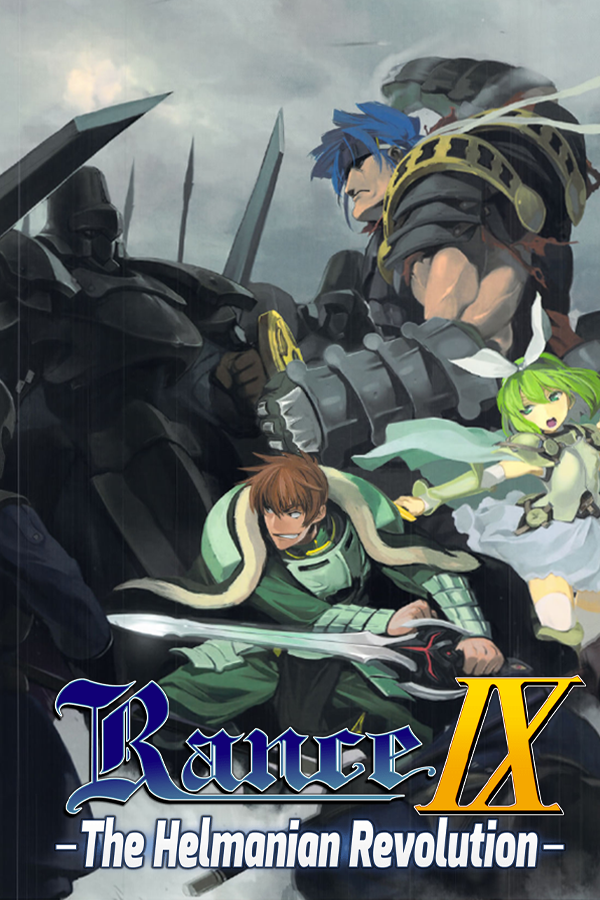
“Rance”,美少女游戏史上的lengendary系列。
In contrast, miHoYo’s 2020 release “Genshin Impact” is one of the highest-grossing nijigen mobile online games globally, with total revenue reaching approximately 3.7 Billion RMB by the end of 2022 [19], and a global user base exceeding 64 million [20].
相比之下,米哈游 2020 年发布的《原神》是全球收入最高的 nijigen 移动网络游戏之一,截至 2022 年底总收入约为 37 亿元人民币 [19],全球用户群超过 6400 万 [20]。
If one “Rance” game has 100,000 paying users and generates 70 million USD in revenue, then from a commercial success perspective, one “Genshin Impact” is equivalent to at least a thousand “Rance” games (needless to say, the time for the process has also been significantly compressed). “Genshin Impact” has brought bishoujo games from the fringes to the global stage, transforming into a social entertainment “internet super platform.” This has extended the nijigen media environment’s tentacle to a diverse audience worldwide, embracing various ideologies and facing unprecedented social complexity.
如果一款“兰斯”游戏有 10 万付费用户并产生 7000 万美元的收入,那么从商业成功的角度来看,一款“原神”至少相当于一千款“兰斯”游戏(不用说,这个过程的时间也被大大压缩了)。《原神》将美少女游戏从边缘带到了全球舞台,蜕变成一个社交娱乐的“互联网超级平台”。这已将 nijigen 媒体环境的触角延伸到全球多元化的受众,拥抱各种意识形态并面临前所未有的社会复杂性。
Nijigen Mobile Games Moving Towards “Erotic Content behind a Mask”
Nijigen手机游戏走向“面具背后的色情内容”
The popularization of bishoujo games also signifies their evolution into “eroticism in disguise”[21] — a form typically embodied by nijigen mobile games. Eroticism is an intrinsic attribute of the nijigen media, serving as the fundamental engine of character consumption. The “mask” signifies the technologization of eroticism, making it both compliant with regulations and amplified. On one hand, there is no explicit erotic content in nijigen mobile games aimed at a broad audience; on the other hand, eroticism is magnified through suggestive implications, creating a space for imagination to surpass the tangible with the intangible.
美少女游戏的普及也标志着它们演变为“变相的色情”[21]——一种典型的形式,体现在二元手机游戏中。情色是 nijigen 媒体的内在属性,是角色消费的基本引擎。“面具”象征着色情的技术化,使其既符合法规又被放大。一方面,针对广大受众的 nijigen 手机游戏中没有露骨的色情内容;另一方面,色情通过暗示性暗示被放大,为想象力创造了一个空间,以无形超越有形。
The technological handling of eroticism in nijigen mobile games involves methods such as encrypted sexuality and empowerment of sexuality:
nijigen手机游戏中对色情的技术处理涉及加密性行为和性赋权等方法:
Encrypted sexuality is a conventional method, where erotic information is embedded into compliant content through new technological means, and players who possess the “key” can decode this erotic information. For instance, in “Genshin Impact,” an open-world game based on real-time rendered 3D animation technology, players can freely choose camera angles to observe characters. Although miHoYo restricts overly explicit angles during climbing scenes, there are still many “gentleman’s views” for players to discover. Some of these views are integrated throughout the game, combined with “Genshin Impact’s” emphasis on body contour in character design, giving the game, rated “14+”in China, an aura of Tezuka Osamu-style eroticism.
加密性行为是一种传统方法,通过新的技术手段将色情信息嵌入到合规的内容中,拥有“密钥”的玩家可以解码这些色情信息。例如,在基于实时渲染 3D 动画技术的开放世界游戏“Genshin Impact”中,玩家可以自由选择摄像机角度来观察角色。虽然米哈游在攀爬场景中限制了过于露骨的角度,但还是有很多“绅士视角”等着玩家去发现。其中一些观点贯穿整个游戏,再加上《原神》在角色设计中对身体轮廓的强调,让这款在中国被评为“14+”的游戏,呈现出手冢治虫式的情色光环。

米哈游以半官方的方式定期发布游戏角色模型:https://www.aplaybox.com/
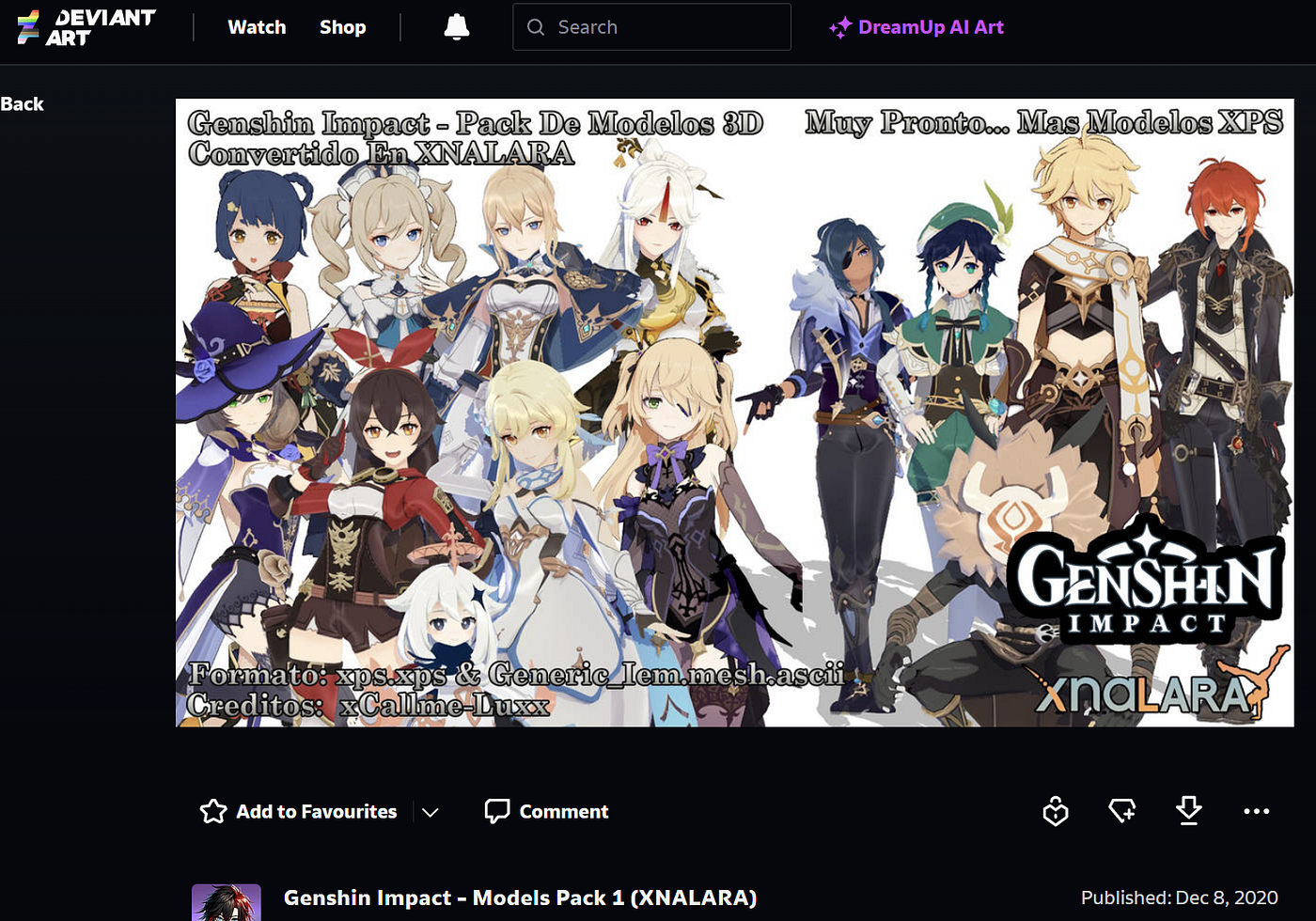
人们在 Deviantart 上重新分发 miHoYo 的公共 Genshin Impact mmd 模型:https://www.deviantart.com/higuys920/art/Genshin-Impact-Models-Pack-1-XNALARA-863409823
The empowerment of sexuality is a novel approach, whereby the production capability for adult content is transferred to player communities based on new technological conditions. Currently, successful nijigen mobile games such as “Azur Lane,” “Blue Archive,” and “Genshin Impact” have established UGC ecosystems for adult content, which is one of the critical factors contributing to their success in the nijigen mobile game industry. Games like “Genshin Impact,” which utilize a famous real-time algorithm-based “nijigen-style rendering” for 3D animation, introduce a novel empowerment approach by openly providing game character model data for players to transplant into other games or 3D software for modification or play. This approach enables player communities to conveniently produce unofficial content of equivalent or sometimes even superior quality compared to official ones.
性赋权是一种新颖的方法,根据新的技术条件,将成人内容的制作能力转移到玩家社区。目前,《Azur Lane》、《Blue Archive》和《Genshin Impact》等成功的 nijigen 手游已经为成人内容建立了 UGC 生态系统,这是促成他们在 nijigen 手游行业取得成功的关键因素之一。像《原神》这样的游戏,利用著名的基于实时算法的“nijigen风格渲染”进行3D动画,通过公开提供游戏角色模型数据供玩家移植到其他游戏或3D软件中进行修改或播放,引入了一种新颖的赋能方法。这种方法使玩家社区能够方便地制作与官方内容质量相当甚至更高的非官方内容。
The character model’s performance in a publicly-facing official games are constrained by technological, legal, and customary limitations. However, once these models enter the private realm of individual users’ professional 3D animation software, their constraints are removed. MiHoYo semi-officially opens almost every character’s model of its released games to the public, governing the use of these models only with non-binding usage terms. While Cygames has not openly released models from “Uma Musume,” they have deliberately or inadvertently set low barriers for data extraction, allowing players relatively free access to the model data of their favorite characters for production and customization, creating content that the official sources cannot provide.
角色模型在面向公众的官方游戏中的表现受到技术、法律和习惯限制的限制。然而,一旦这些模型进入个人用户专业3D动画软件的私人领域,它们的约束就被消除了。米哈游半官方地向公众开放其已发布游戏的几乎所有角色模型,仅使用不具约束力的使用条款来管理这些模型的使用。虽然Cygames没有公开发布“Uma Musume”的模型,但他们有意或无意地为数据提取设置了低门槛,允许玩家相对自由地访问他们最喜欢的角色的模型数据进行制作和定制,创造了官方来源无法提供的内容。
The Confinement of Nijigen Mobile Games: A “Panopticon” for Players
Nijigen手机游戏的禁锢:玩家的“全景图”
Nijigen mobile games, through clever disciplinary design, have transformed the medium into a “Panopticon” that reshapes players through in-game labor.
Nijigen手游通过巧妙的纪律设计,将媒介转变为通过游戏内劳动重塑玩家的“全景图”。
Firstly, this “prison” strips players of ownership over their data. When players spend money on nijigen mobile games, they are essentially paying to unlock more in-game data. This data encompasses both official data and the data generated by players during gameplay. In an era of technolopy within the nijigen industry, most of this data, especially that of the players, is stored in the cloud under the control of the game developers. Players do not gain ownership of the data through their payments; they only obtain the rights to use or lease the data. This means that, on one hand, players lack the authority to modify the in-game data they have paid for (such as creating custom mods), and on the other hand, they do not have the right to permanently retain their private data. Once the game servers shut down, all player data is erased.
首先,这个“监狱”剥夺了玩家对其数据的所有权。当玩家在 nijigen 手机游戏上花钱时,他们本质上是在付费解锁更多的游戏内数据。这些数据包括官方数据和玩家在游戏过程中生成的数据。在nijigen行业的技术时代,大部分数据,尤其是玩家的数据,都存储在游戏开发者控制下的云中。玩家不会通过付款获得数据的所有权;他们只获得使用或租赁数据的权利。这意味着,一方面,玩家无权修改他们已付费的游戏内数据(例如创建自定义模组),另一方面,他们无权永久保留自己的私人数据。一旦游戏服务器关闭,所有玩家数据都会被删除。
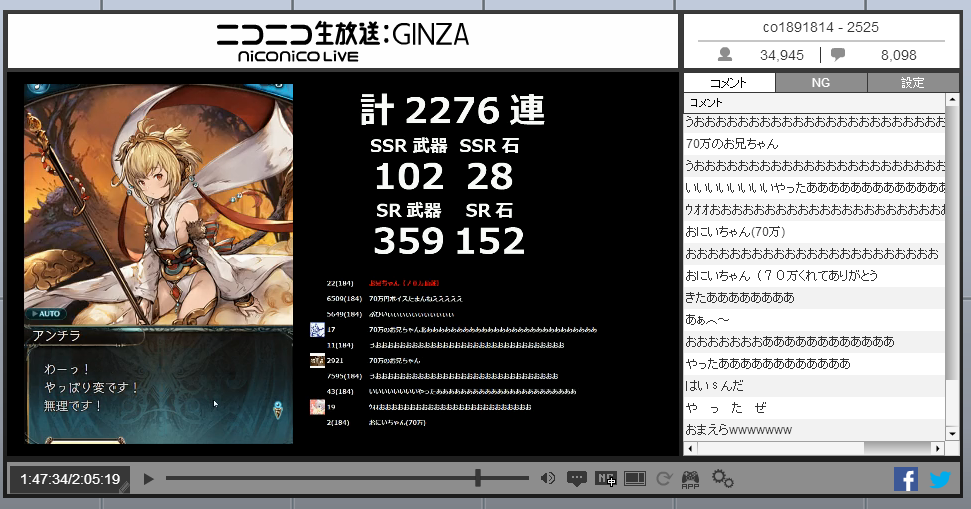
在《碧蓝幻想》的“5000$猴女”事件中,玩家通过直播扭蛋拉扯揭露了开发者的不公平行为,揭露了数据驱动的价格歧视,使忠实玩家处于不利地位。
Secondly, this “prison” is constantly monitoring players. Anime-style mobile games can leverage their always-online nature to collect players’ personal information, while players are left in the dark about the game’s operations. There is a significant information asymmetry between players and developers, allowing the developers to manipulate players through their superior knowledge, such as by pushing customized spending packages⁶ . This creates a form of anonymous technological oppression targeted at players.
其次,这个“监狱”一直在监视玩家。动漫风格的手机游戏可以利用其始终在线的性质来收集玩家的个人信息,而玩家则对游戏的运营一无所知。玩家和开发者之间存在明显的信息不对称,允许开发者通过他们卓越的知识来操纵玩家,例如通过推送定制的支出包⁶。这创造了一种针对玩家的匿名技术压迫形式。
[⁶ For instance, in Cygames’ “5000$ Monkey Girl” incident of Granblue Fantasy, the developers adjusted the in-game gacha machine odds for “whale” players, causing some to spend 70,000 yen (approximately 5000 dollars) to obtain the featured character.]
[⁶ 例如,在Cygames的《碧蓝幻想》的“5000$猴女”事件中,开发者调整了“鲸鱼”玩家的游戏内扭蛋机赔率,导致一些人花费70,000日元(约合5000美元)来获得特色角色。
Thirdly, this “prison” has established a consumer disciplinary system centered around the “gacha machine.” In traditional bishoujo games, players have full control over their playtime and progress, making them the masters of the game. However, the gacha system in nijigen mobile games, designed to exploit human weaknesses, turns players into wage slaves to the game. The gacha system is a gambling-like blind box consumption system that packages game content as prizes with probabilistic drops from the gacha machine, which players can only obtain by spending in-game gacha currency. The acquisition of this currency mainly comes through two channels: fixed and temporary.
第三,这个“监狱”建立了以“扭蛋机”为中心的消费者惩戒体系。在传统的美少女游戏中,玩家可以完全控制他们的游戏时间和进度,使他们成为游戏的主人。然而,nijigen 手机游戏中的扭蛋系统旨在利用人类的弱点,将玩家变成了游戏的工资奴隶。扭蛋系统是一种类似赌博的盲盒消费系统,它将游戏内容打包为奖品,并从扭蛋机上获得概率掉落,玩家只能通过花费游戏内扭蛋货币来获得。这种货币的获取主要通过两个渠道:固定的和临时的。
Fixed channels include two types: real money for gacha currency and game labor⁷ for gacha currency. The former is designed for “whale” players (heavily spending players), while the latter trains “free” or “light-spending” players to become workers who “clock in” daily by logging into the game, as seen in miHoYo’s Honkai Impact 3rd, which even offers years-long daily sign-in rewards to its most loyal “employees.”
固定通道包括两种类型:扭蛋货币的真钱和扭蛋货币的游戏劳动⁷。前者是为“鲸鱼”玩家(高消费玩家)设计的,而后者则训练“免费”或“轻消费”玩家成为每天通过登录游戏“打卡”的工人,正如米哈游的崩坏 3rd 所见,它甚至为其最忠诚的“员工”提供长达数年的每日签到奖励。
Temporary channels further highlight the developers’ manipulation and control over the player community through the gacha currency. If the developers make an operational mistake, compensating with a certain amount of gacha currency can placate players. Developers can also use gacha currency to incentivize players to divulge personal information or sign unfair agreements. Additionally, they can reward a small amount of gacha currency to turn players into their enthusiastic advocates.
临时频道进一步凸显了开发者通过扭蛋货币对玩家社区的操纵和控制。如果开发者犯了操作错误,用一定数量的扭蛋币进行补偿可以安抚玩家。开发者还可以使用扭蛋货币来激励玩家泄露个人信息或签署不公平的协议。此外,他们可以奖励少量扭蛋货币,将玩家变成他们的热情拥护者。
[ ⁷ Such as completing daily sign-ins, daily tasks, battle pass missions (seasonal tasks), etc.]
[ ⁷ 如完成每日签到、每日任务、战令任务(赛季任务)等]
The gacha system in nijigen mobile games not only unprecedentedly intensifies consumption but also forces most players into meaningless, repetitive daily game labor — exchanging hours of low-quality experience for gacha currency — while undergoing continuous brainwashing. This daily sign-in brainwashing is unprecedented in the nijigen media environment.
nijigen手游中的扭蛋系统不仅空前地加剧了消费,还迫使大多数玩家进行无意义、重复的日常游戏劳动——用数小时的低质量体验换取扭蛋币——同时不断进行洗脑。这种每天签到的洗脑在nijigen媒体环境中是前所未有的。
Nijigen Mobile Games Fostering Its Own Ideology: “Post-Bishoujo Fetishism”
培养自己意识形态的Nijigen手机游戏:“后美少女恋物癖”
Under the technopoly, a new ideology has emerged within the nijigen media enviroment, known as “post-bishoujo fetishism.” “Strength”, as the machine performance or function of virtual bishoujo characters, has supplanted the characters themselves, becoming the central agenda in nijigen media. Strength is a technical issue that determines the overall experience in nijigen mobile games — it influences in-game combat damage, the efficiency of clearing levels, and resource collection. Most importantly, in these games, strength is directly tied to the efficiency of obtaining gacha currency, making it the second most significant target of consumption for players after character appeal.
在技术垄断下,在nijigen媒体环境中出现了一种新的意识形态,称为“后美少女拜物教”。“力量”作为虚拟美少女角色的机器表演或功能,已经取代了角色本身,成为nijigen媒体的中心议程。强度是一个技术问题,它决定了 nijigen 手游的整体体验——它会影响游戏中的战斗伤害、通关效率和资源收集。最重要的是,在这些游戏中,实力与获得扭蛋货币的效率直接相关,使其成为仅次于角色吸引力的玩家第二大消费目标。
Strength fetishism, combined with the code-manipulation, gives rise to the “strength ranking.” The strength ranking serves as a competitive platform for both virtual character performance and player’s game assets. On one hand, the extreme scarcity of gacha currency, and on the other hand, the close association between character performance and their token revenue⁸ , transform the game into a colossal arena where players compete fiercely. In this arena, human factors inevitably yield to technology, and virtual bishoujos are subordinated to their strength. Strength, in essence, becomes a universally celebrated “sexual orientation” in nijigen media.
力量拜物教与代码操纵相结合,产生了“力量排名”。实力排名是虚拟角色表现和玩家游戏资产的竞争平台。一方面,扭蛋货币的极度稀缺,另一方面,角色表现与其代币收入之间的密切关联⁸,将游戏变成了一个巨大的竞技场,玩家可以在这里激烈竞争。在这个舞台上,人为因素不可避免地屈服于技术,虚拟美少女从属于他们的力量。从本质上讲,力量成为 nijigen 媒体中普遍庆祝的“性取向”。
[⁸ For instance, in Cygames’ Princess Connect! Re:Dive
[⁸ 例如,在 Cygames 的 Princess Connect!Re:潜水
, top guilds can earn 20 times the tokens compared to the lowest-ranked guilds.]
,与排名最低的公会相比,顶级公会可以获得 20 倍的代币。
If bishoujo games have established a “frigidness towards reality” among otakus, then in the era of technopoly, “post-bishoujo games,” which have dethroned bishoujos from their pedestal, have elevated this detachment to a “frigidness towards the virtual.” For otaku to continually consume new characters, they must swiftly detach from their previous in-game romance. Game developers want players to revere strength above all. While Genshin Impact claim to be content-focused, with bishoujos as content at their core, It does not prevent the system designers from using numerical adjustments to make most players prioritize character strength over character appeal. By intentionally phasing out older characters through strength iteration, they stimulate players to constantly consume new characters. Originally, strength was merely a functional attribute of bishoujos, a subordinate aspect. However, in practice, strength has supplanted bishoujos as the central focus, with content becoming subservient to numbers which is the essence of “post-bishoujo fetishism” in nijigen mobile games.
如果说美少女游戏在御宅族中建立了一种“对现实的冷漠”,那么在技术垄断时代,将美少女从基座上推翻的“后美少女游戏”则将这种超然提升为“对虚拟的冷漠”。为了让宅男不断消耗新角色,他们必须迅速摆脱之前的游戏恋情。游戏开发者希望玩家首先尊重力量。虽然 Genshin Impact 声称以内容为中心,以美少女为核心,但这并不妨碍系统设计者使用数字调整来让大多数玩家优先考虑角色强度而不是角色吸引力。通过有意通过力量迭代逐步淘汰旧角色,他们刺激玩家不断消耗新角色。最初,力量只是美少女的一个功能属性,一个从属的方面。然而,在实践中,实力已经取代了美少女成为中心焦点,内容变得屈从于数字,这是《后美少女恋物癖》在nijigen手机游戏中的本质。
Whenever otaku lavishly spend to draw virtual bishoujos from gacha-style slot machines, it mimics an ejaculatory experience — an intense moment of gratification followed by profound emptiness. This dopamine-driven structural psychological deficiency becomes the engine of virtual character consumption.
每当宅男大手大脚地从扭蛋式老虎机上抽取虚拟美少女时,它都会模仿一种射精体验——一种强烈的满足感,然后是深深的空虚。这种多巴胺驱动的结构性心理缺陷成为虚拟角色消费的引擎。
In conclusion, within the nijigen media environment dominated by technopoly, it has evolved into a “prison” or even a “religion.” Beneath the surface, this phenomenon reveals an invisible power structure, where technology and capital collude to dominate a predominantly one-dimensional otaku populace — the consumer otaku.
总之,在技术垄断主导的nijigen媒体环境中,它已经演变成一个“监狱”甚至“宗教”。在表面之下,这种现象揭示了一种无形的权力结构,技术和资本勾结在一起,主宰着一个主要是一维的宅男群体——消费者宅男。
A substantial amount of the latest media technologies is directed towards taming otaku into zealous consumers and reshaping them into “workers” for capital both within and outside of nijigen gaming systems. The value orientation of the nijigen does not prioritize technological innovation or enhancing player experiences; instead, it steadfastly focuses on one technical goal — how to efficiently deplete the wallets of consumer otaku.
大量最新的媒体技术旨在将御宅族驯服为狂热的消费者,并将他们重塑为Nijigen游戏系统内外的资本“工人”。nijigen的价值取向并不优先考虑技术创新或增强玩家体验;相反,它坚定不移地专注于一个技术目标——如何有效地耗尽消费者宅男的钱包。
The Transformation of Nijigen Negative Externalities: The miHoYo Model
Nijigen负外部性的转变:miHoYo模型
If 如果 the aesthetics of “mechanical brides” thrives on rapid technological iteration, then in a society primarily composed of consumer otaku, the nijigen ecology inevitably tends towards technology monopoly. Technopoly reflect a distorted, one-dimensional relationship between technology and human — a segregation where individuals become subservient to technology. Blind worship or hostility towards technology stems from ignorance and powerlessness in relation to it. To break free from technopoly, a mutual, two-dimensional, symbiotic relationship must be constructed between individuals and technology, otaku and “mechanical brides.”
《机械新娘》的美学在快速的技术迭代中茁壮成长,那么在一个主要由消费宅男组成的社会中,Nijigen生态不可避免地趋向于技术垄断。技术垄断反映了技术与人类之间扭曲的一维关系——一种个人屈从于技术的隔离。对技术的盲目崇拜或敌意源于对技术的无知和无能为力。为了摆脱技术垄断,必须在个人与技术、宅男和“机械新娘”之间建立一种相互的、二维的、共生的关系。
The rise of miHoYo illustrates that tech-otakus, as digital makers, serve as antidotes to the negative externalities of the nijigen in this way. Otakus can emulate miHoYo’s approach to reshape the world “in their own image”, thereby achieving self-governance themselves and finding their way back to the future.
miHoYo 的兴起表明,作为数字制造者,科技宅男以这种方式充当了 nijigen 负面外部性的解毒剂。宅男可以效仿 miHoYo 的方法,“按照自己的形象”重塑世界,从而实现自己的自治并找到回到未来的道路。
miHoYo: The Neo-Schumpeterism in a Nijigen Shape
miHoYo:Nijigen形状的新熊彼特主义
miHoYo was founded in 2011 by three computer science graduates from Shanghai Jiao Tong University. The Chinese character “mi” in miHoYo was phonetically named after “Hatsune Miku,” the first voice synthesis software in a nijigen shape, while their debut work “Fly Me 2 the Moon” draws its name from the ending theme of the iconic otaku animation TV series “Neon Genesis Evangelion” (referred to as EVA later in this text). Throughout the growth stages of miHoYo’s flagship product “Honkai Impact 3rd,” one can consistently find tributes to EVA (such as the Valkyries’ battle suits), and they even organized a “dream-comes-true collaboration” with EVA that players jokingly dubbed a “players-funded offical star-chasing event.” Japanese critic Tunehiro Uno pointed out that the decline of the socialist movements in the late 20th century shifted Japan’s otaku culture from constructing grand fictional narratives to focusing on their own inner selves, reducing complex social relationships to the entanglements of adolescent boys and girls. This shift moved from ideological “narratives” to non-ideological “information.” Otaku no longer seek to change the outer world actively but instead focus on changing their own inner selves. They no longer need to establish connections between themselves and the world in fiction but rather detach from the world, reducing all worldly problems to issues of self-awareness within. Director Hideaki Anno’s “EVA” illustrates Japan’s otaku post-Soviet dissolution, transitioning from ambitious space operas to gentle realms of fictional bishojos [22]. In contrast, miHoYo, who declares to actively “save the world,” represents Chinese otaku addressing the nijigen governance issues of the digital-capitalism era with a completely different approach.
miHoYo 由三位毕业于上海交通大学的计算机科学专业毕业生于 2011 年创立。miHoYo 中的汉字“mi”在语音上以第一款 nijigen 形状的语音合成软件“Hatsune Miku”命名,而他们的处女作“Fly Me 2 the Moon”的名字来源于标志性的宅男动画电视剧《霓虹创世纪福音战士》(本文后面称为 EVA)的片尾主题。在米哈游旗舰产品《崩坏3rd》的整个成长阶段,人们总能找到对EVA的致敬(比如女武神的战斗服),他们甚至与EVA组织了一场“梦想成真”的合作,玩家们开玩笑地称之为“玩家资助的官方追星活动”。日本评论家宇野曲宏指出,20世纪末社会主义运动的衰落,使日本的御宅族文化从构建宏大的虚构叙事转向关注自己的内在自我,将复杂的社会关系简化为青春期男孩和女孩的纠葛。这种转变从意识形态的“叙事”转向非意识形态的“信息”。宅男不再寻求积极改变外部世界,而是专注于改变自己的内在自我。他们不再需要在小说中建立自己与世界之间的联系,而是脱离世界,将所有世俗问题简化为内在的自我意识问题。导演庵野秀明的《EVA》展现了苏联解体后日本宅男的形象,从雄心勃勃的太空歌剧过渡到虚构的美少女的温柔境界[22]。相比之下,宣称积极“拯救世界”的米哈游则代表了中国宅男以完全不同的方式解决数字资本主义时代的治理问题。
In 2012, miHoYo launched the “Honkai” IP series with their offline bishoujo game, “Honkai Gakuen.” Their first significant financial success, however, came from “Honkai Gakuen 2” (2014-, hereafter referred to as “Honkai 2”), which capitalized on in a technolopy way. At this point, miHoYo’s technological advancements were still at a standstill, with the three tech-otakus only just beginning to understand the business model of nijigen mobile games through “Honkai 2.” miHoYo’s journey of technological innovation truly began with “Honkai Impact 3rd” (2016-, hereafter referred to as “Honkai 3”), built upon the primitive accumulation from “Honkai 2.”
2012年,米哈游推出了“崩坏”IP系列,推出了他们的离线美少女游戏“崩坏学园”。然而,他们的第一个重大财务成功来自“崩坏学园 2”(2014 年-,以下简称“崩坏 2”),它以技术的方式利用了这一点。至此,米哈游的技术进步仍处于停滞状态,三位科技宅男才刚刚开始通过《崩坏2》了解二元手游的商业模式,米哈游的技术创新之旅真正开始于《崩坏3》(2016-,以下简称《崩坏3》),建立在《崩坏2》的原始积累之上。
Analyzing miHoYo’s patents of invention in China , we can observe that their technological accumulation began with “Honkai 3.” “Honkai 3” was among the first to move beyond the fiercely competitive traditional 2D animation track and enter the high-tech realm of mid-to-high-poly 3D animation production for nijigen mobile games which had been regarded as symbols of low-tech for a long time within the gaming industry. One of the core designs of nijigen mobile games is the digital animation design that showcases character appeal. The real-time computational power and storage capacity required for 3D animation (modeling, rendering, etc.) are far greater than for 2D animation.
分析米哈游在中国的发明专利,我们可以观察到,他们的技术积累是从《崩坏3》开始的。《崩坏3》是率先超越竞争激烈的传统2D动画赛道,进入中高多边形3D动画制作的高科技领域,为在游戏行业内长期被视为低技术象征的二元手机游戏。nijigen手游的核心设计之一是展示角色魅力的数字动画设计。3D动画(建模、渲染等)所需的实时计算能力和存储容量远远大于2D动画。
The difference between game animation and general digital animation (such as digital effects in movies or digital animated films) lies in that the former is generated in real-time through calculations, while the latter is pre-recorded after rendering is complete. Game animation signifies the cyberization of animation, transforming it into an automata that integrates with the viewer. The machine generates different animations in real time based on viewer interactions. As media technologies advance and the modes of interaction between audiences and machines become increasingly limitless, real-time animation too will evolve endlessly. Ultimately, this leads to the formation of a ‘metaverse’ that approaches an infinite closeness to the real world.
游戏动画与一般数字动画(如电影中的数字特效或数字动画电影)的区别在于,前者是通过计算实时生成的,而后者是在渲染完成后预先录制的。游戏动画意味着动画的网络化,将其转变为与观众融为一体的自动机。机器根据观众的互动实时生成不同的动画。随着媒体技术的进步,观众与机器之间的互动模式变得越来越无限,实时动画也将不断发展。最终,这导致了“元宇宙”的形成,它接近于现实世界的无限接近。
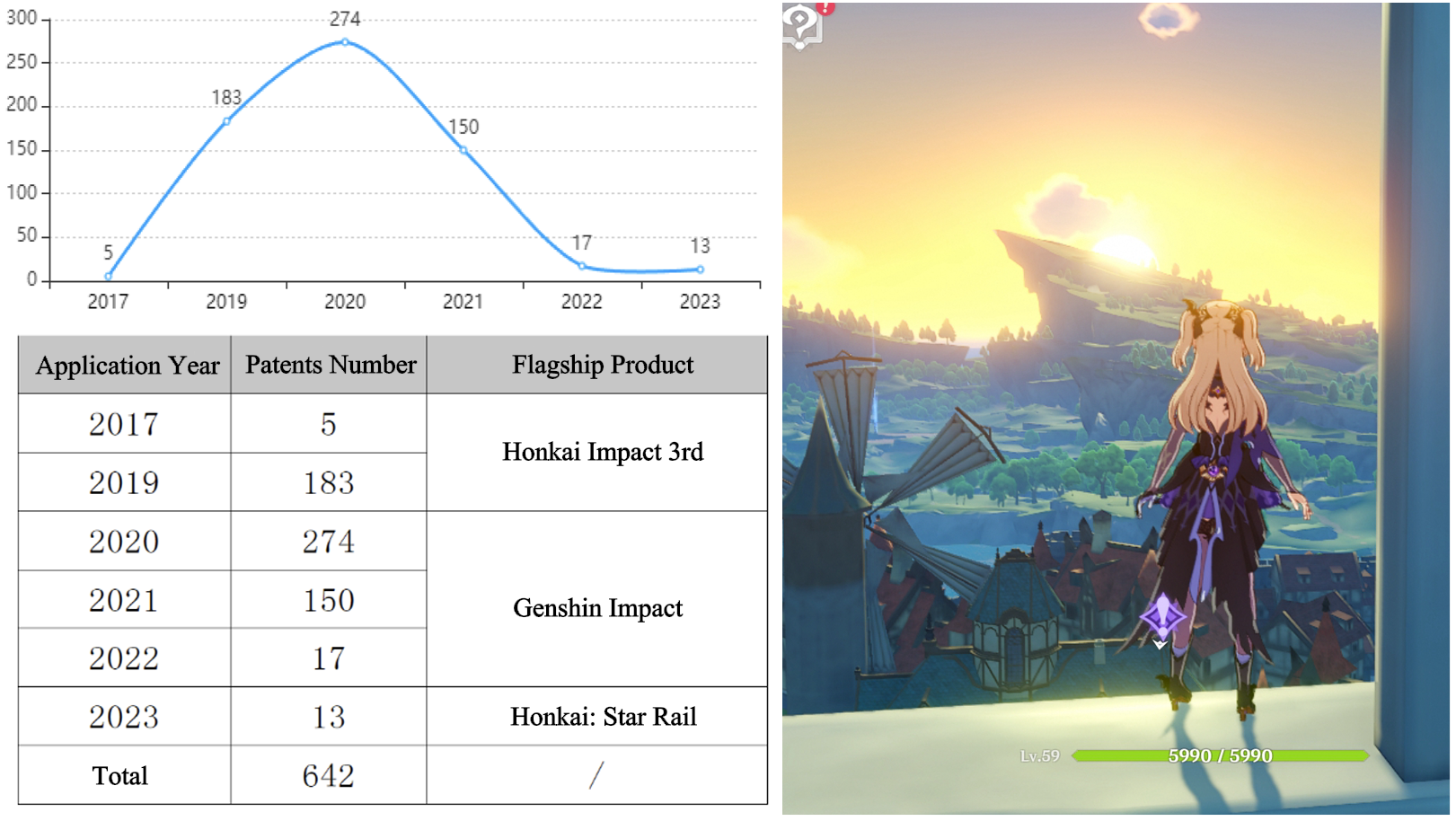
左图:截至2023年12月,米哈游每年提交的专利申请量[23]。右图:仅凭能够操纵美少女角色并自由欣赏来自游戏世界的风景,《原神》就为大多数消费者宅男提供了前所未有的体验(游戏截图)。
The development of “Honkai 3” required surmounting two major computational challenges on mobile platforms: firstly, the transition from 2D to 3D animation; secondly, the adaptation to real-time computation of 3D animation. MiHoYo adopted a long-term development model that runs research and operations concurrently, investing substantial game profits into groundbreaking technological innovations. In the second year of “Honkai 3,” miHoYo filed for its first batch of patents of invention (5 in total). Before the release of “Genshin Impact” in 2019, there was an explosive increase in patents of invention filed by miHoYo (183 items). Meanwhile, “Honkai 3” leveraged miHoYo’s unique “nijigen-style rendering” 3D animation technology to outperform competitors and establish a core fan base. The game also enjoyed the benefits of a technopoly, intensifying consumption that a full gaming experience requires significant spending to a degree that far surpasses its predecessor. Thus, “Honkai 3” laid the financial and technological groundwork for miHoYo’s second major leap: the high-definition, open-world⁹ nijigen mobile game “Genshin Impact.”
《崩坏3》的开发需要克服移动平台上的两大计算挑战:第一,从2D动画到3D动画的过渡;其次,适应3D动画的实时计算。米哈游采用长期开发模式,同时进行研究和运营,将大量游戏利润投入到突破性的技术创新中。在《崩坏3》的第二年,米哈游申请了第一批发明专利(共5项)。在 2019 年《原神》发布之前,米哈游提交的发明专利呈爆炸式增长(183 项)。同时,《崩坏3》利用米哈游独有的“日治式渲染”3D动画技术,超越竞争对手,建立核心粉丝群。该游戏还享受了技术垄断的好处,加剧了消费,即完整的游戏体验需要大量支出,其程度远远超过其前作。因此,《崩坏3》为米哈游的第二次重大飞跃奠定了财务和技术基础:高清、开放世界⁹的nijigen手机游戏《原神》。
[⁹ “Genshin Impact” primarily utilizes high-poly models for real-time 3D animation, requiring significant computational power capacity as model details increases. While “Genshin Impact” is widely recognized as a pioneering open-world game in the mobile gaming industry, it is important to note that there were predecessors like the mobile version of “Minecraft” with its pixel-style, low-poly model open world. Therefore, referring to “Genshin Impact” as a high-poly open world or high-definition open world would be more precise.]
[⁹ “Genshin Impact”主要利用高多边形模型进行实时 3D 动画,随着模型细节的增加,需要大量的计算能力。虽然《原神》被广泛认为是移动游戏行业的开创性开放世界游戏,但需要注意的是,有一些前辈,如移动版的《我的世界》,其像素风格、低多边形模型的开放世界。因此,将“Genshin Impact”称为高多边形开放世界或高清开放世界会更准确。
MiHoYo’s “Genshin Impact”(2020) has ventured into uncharted territories within the realm of nijigen mobile games, and even within the broader nijigen media environmnet. “Honkai 3” belongs to the category of “bonsai” (miniature garden) games — where interactions between players and characters are confined to small virtual spaces, and the interactions between characters, as well as between characters and the environment, are relatively limited. In contrast, “Genshin Impact” transforms the confined “miniature garden” into an expansive “real world,” creating an enormous, high-definition, and highly simulated virtual space where all interactions among players, characters, and the environment are computed in real-time on mobile devices with limited computing power capacity.
米哈游的“Genshin Impact”(2020 年)在 nijigen 手机游戏领域,甚至在更广泛的 nijigen 媒体环境中,都涉足了未知领域。《崩坏3》属于“盆景”(微型花园)游戏的范畴,玩家与角色之间的互动被限制在狭小的虚拟空间中,角色之间以及角色与环境之间的互动相对有限。相比之下,《原神》将封闭的“微型花园”转变为广阔的“现实世界”,创造了一个巨大、高清、高度模拟的虚拟空间,玩家、角色和环境之间的所有互动都是在计算能力有限的移动设备上实时计算的。
From “Honkai 3” to “Genshin Impact,” miHoYo had to surmount significant technical challenges and complex engineering tasks, marking the third major hurdle the company has overcome. “Genshin Impact” is often compared to Nintendo’s “The Legend of Zelda: Breath of the Wild” for their similar open world game-play design, although such comparisons are not entirely equitable due to their differing technological frameworks — the former is designed for specially-designed professional gaming consoles, while the latter is optimized across various devices, including medium-end smartphones. This compatibility is one of the key factors behind ‘Genshin Impact’s’ commercial success, as it brings a professional gaming experience, comparable to “Breath of the Wild,” to virtually everyone’s smartphone. MiHoYo’s core technological achievement can be summarized in one sentence — achieving large-scale real-time computation of 3D animations within the constraints of limited hardware.
从《崩坏3》到《原神》,米哈游必须克服重大的技术挑战和复杂的工程任务,这是该公司克服的第三个主要障碍。《原神》经常被拿来与任天堂的《塞尔达传说:旷野之息》相提并论,因为它们的开放世界游戏设计相似,尽管由于技术框架不同,这种比较并不完全公平——前者是为专门设计的专业游戏机设计的,而后者则针对各种设备进行了优化,包括中端智能手机。这种兼容性是《原神》商业成功背后的关键因素之一,因为它为几乎每个人的智能手机带来了与《旷野之息》相媲美的专业游戏体验。米哈游的核心技术成就可以用一句话来概括——在有限的硬件限制下实现3D动画的大规模实时计算。
For competitors who have stagnated technologically, this represents a significant “dimensional reduction strike.” In its first year of operation, miHoYo reached a peak in the number of filed patents of invention(274). By the end of 2022, the number of patents during the operational period of ‘Genshin Impact’ was more than double that of ‘Honkai 3’ (441). A comparison of patent filings among Chinese peers also highlights miHoYo’s exceptional technological innovation in the China’s gaming industry.
对于在技术上停滞不前的竞争对手来说,这代表着一次重大的“降维罢工”。在运营的第一年,米哈游的发明专利申请数量达到了顶峰(274项)。截至 2022 年底,《原神》运营期间的专利数量是《崩坏 3》的两倍多(441 项)。通过对中国同行专利申请的比较,也凸显了米哈游在中国游戏行业的卓越技术创新。
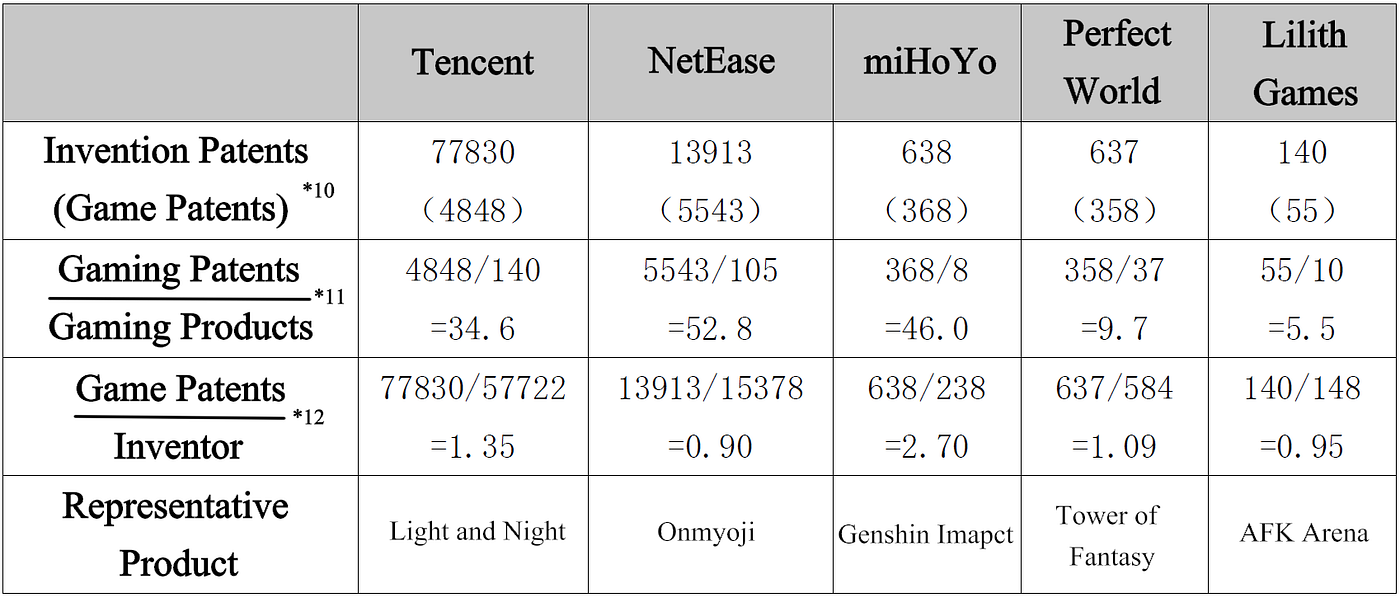
通过专利评估米哈游的技术创新(截至2023年12月)[24]
[¹⁰ Given that Tencent and NetEase have numerous non-gaming businesses, the number of “game patents” is derived from the total count of patents under all IPC groups related to game development, such as A63F13 (video games), G06T13 (animation production), and G06T15 (processing of 3D images), and is individually compared.
[¹⁰ 鉴于腾讯和网易拥有众多非游戏业务,“游戏专利”的数量来自所有与游戏开发相关的IPC组别的专利总数,如A63F13(视频游戏)、G06T13(动画制作)和G06T15(3D图像处理),并单独进行比较。
¹¹ The patent-to-product ratio is calculated by dividing the number of game-related patents by the number of game products of the applicant. The count of products includes all games developed by the applicant, not just nijigen mobile games, and excludes any discontinued games. The data is collected from the official websites of the companies. Considering that established game companies like Tencent, NetEase, and Perfect World have discontinued many released online games (which are now difficult to quantify), the actual patent-to-product ratio is significantly lower than the figures suggest above.
¹¹ 专利与产品的比率是通过将游戏相关专利数量除以申请人的游戏产品数量来计算的。产品数量包括申请人开发的所有游戏,而不仅仅是nijigen手机游戏,不包括任何已停产的游戏。数据是从公司的官方网站收集的。考虑到腾讯、网易、完美世界等老牌游戏公司已经停产了许多已发行的网络游戏(现在很难量化),实际专利与产品的比例明显低于上述数字。
¹² The patent-to-inventor ratio equals the total number of patents held by the primary applicant divided by the number of inventors, which is the sum of inventors listed annually.]
¹² 专利与发明人的比率等于主申请人持有的专利总数除以发明人数量,即每年列出的发明人总数。
In terms of the total number of patents, miHoYo stands at the forefront of the entire Chinese gaming industry. Although Tencent and NetEase surpass miHoYo in total patent count due to their longer history and broader business scope, miHoYo closely trails NetEase in the “patent-product ratio.” This indicates that miHoYo’s technological innovations per game product may even exceed those of Tencent. Furthermore, miHoYo significantly outperforms other major Chinese game developers in the “patent-inventor ratio,” suggesting that miHoYo has established highly innovative core R&D team. The otaku’s passion has been transformed into a new element of innovation under miHoYo’s stewardship. With ample financial backing, the creative and innovative spirit of tech-otaku inventors is unparalleled in China’s gaming sector.
就专利总数而言,米哈游伎俩乖��尽管腾讯和网易由于历史悠久、业务范围更广,在专利总数上超过了米哈游,但米哈游在“专利产品比”上紧随网易之后。这表明米哈游每款游戏产品的技术创新甚至可能超过腾讯。此外,米哈游在“专利发明人比例”方面明显优于其他主要中国游戏开发商,这表明米哈游已经建立了高度创新的核心研发团队。御宅族的热情在米哈游的管理下已经转化为新的创新元素。在充足的资金支持下,科技宅男发明家的创造力和创新精神在中国游戏行业是无与伦比的。
When narrowing the focus to the nijigen niche, miHoYo dominates as a colossal force. Although other nijigen-focused game companies like HyperGryph, Yostar, and Kuro Games have achieved certain commercial successes, their lack of patent outputs reveal their relatively lower capacity for technological innovation.
当将焦点缩小到 nijigen 利基市场时,miHoYo 作为一股巨大的力量占据主导地位。尽管其他专注于 nijigen 的游戏公司,如 HyperGryph、Yostar 和 Kuro Games 已经取得了一定的商业成功,但它们缺乏专利产出表明它们的技术创新能力相对较低。
The miHoYo Model: Three Circulation of Otaku Technological Innovation
米哈游模式:御宅族技术创新的三流通
In summary, miHoYo’s success primarily stems from three key aspects:
总而言之,米哈游的成功主要源于三个关键方面:
(1) Deep Dive into Media Technology
(1) 深入研究媒体技术
- A true craftsman (maker) is someone who relentlessly hones his or her craft to the point of being irreplaceable. Tech otakus are a sophisticated form of maker, as technology for them is not merely a means of livelihood but also a way to break the “fourth wall” between the virtual and real worlds. For tech otakus, money is just a tool, while creating the “mechanical bride” is the ultimate goal. The concept of an “open world” is not a stock price gimmick but an actionable objective. This is why miHoYo invested most of the profits from “Honkai 3” into the development of “Genshin Impact”, a highly challenging and uncertain project. The otaku DNA of these tech enthusiasts is the fundamental reason why miHoYo exhibits more creative vitality compared to Tencent and NetEase.
真正的工匠(制造者)是那些坚持不懈地磨练自己的手艺到不可替代的地步的人。科技宅男是一种复杂的制造者,因为技术对他们来说不仅仅是一种谋生手段,也是打破虚拟世界和现实世界之间“第四堵墙”的一种方式。对于科技宅男来说,金钱只是一种工具,而创造“机械新娘”才是最终目标。“开放世界”的概念不是股价的噱头,而是一个可操作的目标。这就是为什么米哈游将《崩坏3》的大部分利润投入到《原神》的开发中,这是一个极具挑战性和不确定性的项目。这些科技爱好者的御宅族DNA是米哈游比腾讯、网易更具创意活力的根本原因。
(2) Technologization of Eroticism
(2)色情技术化
- Sexuality is a basic living-being’s need and a major driving force for human creation and consumption, being one of the most universal elements of human culture. The birth of otaku culture is closely linked to the technologization and mechanization of sexuality, with tech otakus being the main drivers of this process in the digital society. The technologization of sexuality faces two types of limitations: physical constraints, such as machine computing and storage capacity, and social norms, such as laws, religion, and customs. The latter tend to lag behind, meaning that even if technology overcomes physical limitations, social restrictions may still go on. Tech otakus are new-types who pursue “emotional companions” in the machine world while being flesh-and-blood individuals. MiHoYo’s success also lies in their significant utilization of otaku sexual anxieties, breaking physical limitations within the bounds of social norms to provide real-world living experiences that people genuinely crave. They foresee that in the future, such experiences will inevitably be generated and enhanced by machines.
性是生物的基本需求,是人类创造和消费的主要驱动力,是人类文化中最普遍的元素之一。御宅族文化的诞生与性行为的技术化和机械化密切相关,科技御宅族是数字社会中这一过程的主要驱动力。性技术化面临两类限制:物理限制,如机器计算和存储能力,以及社会规范,如法律、宗教和习俗。后者往往落后,这意味着即使技术克服了物理限制,社会限制仍可能继续存在。科技宅男是新型的,他们在机器世界中追求“情感伴侣”,同时又是有血有肉的个体。米哈游的成功还在于他们大量利用御宅族的性焦虑,在社会规范的范围内打破身体限制,提供人们真正渴望的真实世界的生活体验。他们预见到,在未来,这种体验将不可避免地由机器产生和增强。
(3) Fanatical Consumption Under Technological Discipline
(3)技术规训下的狂热消费
- Technology can be transformed into power, enabling new forms of social control or governance. In the era of technopoly, tech otakus, through internet systems, gain unrivaled dominance by controlling data, while consumer otakus find themselves in an unprecedentedly weak position. The combination of bishoujo games and internet systems has created a disciplinary regime for nijigen mobile games. MiHoYo is one of the beneficiaries of technopoly; its high-tech products system not only amplifies player consumption behaviors but also invades the ideological domain of players like a “religion,” turning them into devoted followers who unconditionally dedicate themselves to and defend miHoYo.
技术可以转化为权力,实现新的社会控制或治理形式。在技术垄断时代,科技宅男通过互联网系统通过控制数据获得无与伦比的主导地位,而消费者宅男则发现自己处于前所未有的弱势地位。美少女游戏和互联网系统的结合为nijigen手机游戏创造了纪律制度。米哈游是技术垄断的受益者之一;其高科技产品体系不仅放大了玩家的消费行为,还像“宗教”一样侵入了玩家的意识形态领域,将他们变成了无条件献身于米哈游的忠实追随者。
From these three aspects, we can see that miHoYo has established three circulations of innovation around technology[25]:
从这三个方面可以看出,米哈游围绕技术建立了三大创新循环[25]:

资本、权力、爱:米哈游建立的技术创新三环。
- Capital Circulation of Technological Innovation: Technological innovation drives profit growth in products, which in turn increases investment in technology. This positive feedback loop between a company’s technological and financial capital forms the cornerstone of innovation for high-tech companies like Nvidia and Intel.
技术创新的资本循环:技术创新带动产品利润增长,进而增加技术投资。公司技术和金融资本之间的这种正反馈循环构成了英伟达和英特尔等高科技公司创新的基石。 - Dominance Circulation of Technological Innovation: Technological innovation strengthens technolopy, enhancing control over users. This control then facilitates societal acceptance of further innovations, creating positive feedback loop between a company’s technological and social capital. In this circulation, the company’s soft power, brand influence, and societal impact continually escalate, a strategy favored by mass-market consumer-oriented tech giants like Facebook and Apple.
技术创新的支配流通:技术创新加强了技术,增强了对用户的控制。然后,这种控制促进了社会对进一步创新的接受,在公司的技术和社会资本之间创造了积极的反馈循环。在这种循环中,公司的软实力、品牌影响力和社会影响力不断升级,这是 Facebook 和苹果等面向大众市场的以消费者为导向的科技巨头所青睐的策略。 - Love Circulation of Technological Innovation: Technological advancements have led to the high-definition and intelligent rendering of “digital mai waifu”. This enhanced clarity and intelligence in “mechanical bride” serves as the driving force behind the innovative spirit of tech-otakus. Creating for love and driven by love, the synergy between a company’s technological and nijigen capital forms a positive feedback loop. This circulation of technological innovation is distinctive to tech-otaku companies like miHoYo.
爱流通科技创新:科技进步催生了“数字迈外福”的高清智能渲染。“机械新娘”的这种增强的清晰度和智能性是科技宅男创新精神背后的驱动力。为爱而创造,以爱为动力,公司的技术和nijigen资本之间的协同作用形成了一个正反馈循环。这种技术创新的循环是像miHoYo这样的科技宅男公司所独有的。
These three circulations of technological innovation constitute the “miHoYo model.”
这三种技术创新的循环构成了“米哈游模式”。
All for Love: Technological Monopoly as Fuel for Technological Acceleration
一切为了爱:技术垄断是技术加速的燃料
The foundation of the miHoYo model is the tech-otaku model, where innovation is driven by love. miHoYo has enhanced the traditional self-sufficient, self-entertaining small workshop model of tech otakus by incorporating modules of power and capital, significantly accelerating the development of technology in the nijigen media. In the miHoYo model, technology does not become subservient to capital and power; instead, capital and power are harnessed to serve the purposes of technology. The distinction between miHoYo and other high-tech companies lies in technology being subordinate to love, the use value of technology. The ultimate goal of the intricate interplay between technology, capital, and power is directed towards the affection for the “mechanical bride.”
米哈游模式的基础是科技宅男模式,其中创新是由爱驱动的。米哈游通过整合权力和资本模块,增强了科技宅男传统的自给自足、自娱自乐的小作坊模式,大大加速了nijigen媒体的技术发展。在米哈游模型中,技术不会屈从于资本和权力;取而代之的是,资本和权力被用于服务于技术的目的。米哈游与其他高科技公司的区别在于技术从属于爱,技术的使用价值。技术、资本和权力之间错综复杂的相互作用的最终目标是针对对“机械新娘”的感情。
Companies like Tencent and NetEase, major players in China’s gaming industry with substantial funding and research capabilities, have developed hundreds of games but have not created a phenomenon like “Genshin Impact.” As The New York Times describes, it is “a nearly picture-perfect reproduction of Japanese fantasy role-playing games, has raked in billions of dollars and sent shock waves through the world’s aging video game superpower.” [26] This discrepancy arises because, in the face of market complexities, pursuing quantity poses less risk than striving for quality. When capital or power takes precedence, a company or studio has little reason to invest all its resources into a high-risk, high-quality product, let alone the “bottomless pit” of technological innovation.
像腾讯和网易这样的公司是中国游戏行业的主要参与者,拥有大量资金和研究能力,已经开发了数百款游戏,但没有创造出像《原神》这样的现象。正如《纽约时报》所描述的那样,它是“日本奇幻角色扮演游戏的近乎完美的复制品,已经赚了数十亿美元,并通过世界上老化的视频游戏超级大国发出了冲击波。[26]之所以出现这种差异,是因为面对复杂的市场,追求数量比追求质量带来的风险要小。当资本或权力占上风时,公司或工作室几乎没有理由将所有资源投入到高风险、高质量的产品上,更不用说技术创新的“无底洞”了。
MiHoYo understands the logic of capital and power but subordinates them to futuristic use value, the ultimate goal of tech otakus: creating the perfect “mechanical bride.” Unlike building a pyramid, what the “mechanical bride” truly needs is not more money or power but love, alongside continuously evolving quality.
米哈游理解资本和权力的逻辑,但将它们从属于未来主义的使用价值,这是科技宅男的最终目标:创造完美的“机械新娘”。与建造金字塔不同,“机械新娘”真正需要的不是更多的金钱或权力,而是爱,以及不断发展的质量。
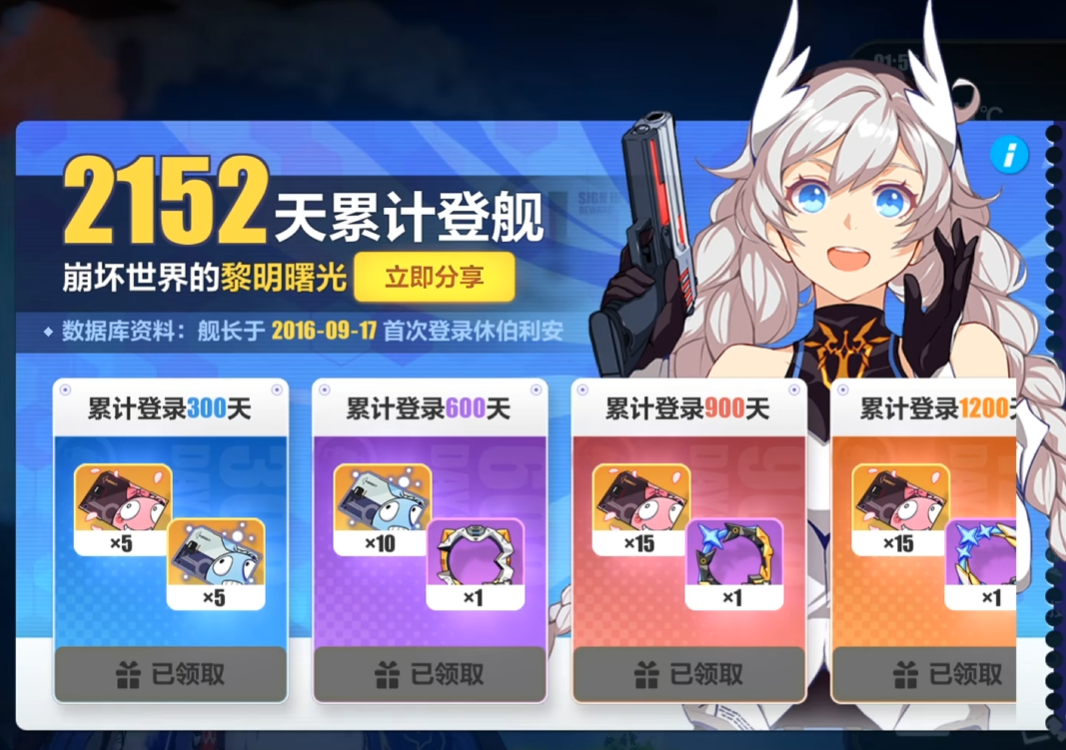
《崩坏3rd》多年玩家全场奖
To some extent, miHoYo is creating a miniature “Brave New World,” where a few tech-otakus use new technology to dominate a vast number of consumer-otakus through their products. On one hand, miHoYo has leveraged technological innovation to resolve the conflict between limited machine computing power capacity and the need for massive real-time computations required for generating a high-definition virtual open world. This has allowed them to bring open-world games, almost comparable to AAA game titles, to mobile platforms, providing otaku with an unprecedented sense of freedom. On the other hand, instead of choosing a single-player mode that empowers players with technological openness, they opted for a network mode characterized by technopoly, thus stripping players of the freedom to arrange their game time, progress, and modify game data — effectively shackling them. In this process, otakus trade one form of freedom for another. Without the fervent consumption by consumer-otakus, miHoYo’s tech-otakus would lack the necessary funds to develop groundbreaking open-world mobile games. Conversely, if miHoYo couldn’t provide an unique and carefree experience within the open world, consumer-otakus wouldn’t sacrifice their own freedom and willingly submit to miHoYo’s control.
在某种程度上,米哈游正在创造一个微型的“美丽新世界”,在这个世界中,一些科技宅男利用新技术通过他们的产品主宰了大量的消费者宅男。一方面,米哈游利用技术创新解决了有限的机器算力与生成高清虚拟开放世界所需的海量实时计算需求之间的冲突。这使他们能够将几乎可以与 AAA 游戏相媲美的开放世界游戏带到移动平台,为宅男提供前所未有的自由感。另一方面,他们没有选择赋予玩家技术开放性的单人游戏模式,而是选择了以技术垄断为特征的网络模式,从而剥夺了玩家安排游戏时间、进度和修改游戏数据的自由——有效地束缚了他们。在这个过程中,宅男用一种形式的自由换取另一种形式的自由。如果没有消费者宅男的狂热消费,miHoYo 的科技宅男将缺乏开发突破性开放世界手机游戏所需的资金。相反,如果 miHoYo 不能在开放世界中提供独特而无忧无虑的体验,消费者宅男就不会牺牲自己的自由,心甘情愿地屈服于 miHoYo 的控制。
It is evident that miHoYo has transformed the negative externalities of the nijigen into positive externalities through technological innovation. They use technological monopoly as fuel for technological acceleration, subsequently burying the technopoly through this acceleration. For instance, miHoYo has made certain core data (like character models) public to players, modified the daily task mechanism to reduce repetitive game labor, and lowered the guaranteed price in the gacha system. After establishing high product profitability through technological acceleration, they changed their user strategy, offering more benefits to players and encouraging competitors to do the same; otherwise, their users would flock to miHoYo’s higher-quality, more generous offerings. The “good money driving out bad” shock that Genshin Impact brought to the industry lies in miHoYo’s establishment of core competitiveness through technological innovation and quality engineering based on love. This delivered a “dimensional reduction strike” to their peers, forcing various capitals to stop cycling through low-quality, wealth-transfer “bullshit projects.” MiHoYo has declared the end of the speculative era of barbaric expansion and the advent of an era of high-quality, maker-driven development, marking the greatest positive externality miHoYo has brought to the world.
可见,米哈游通过技术创新,将nijigen的负外部性转化为正外部性。他们利用技术垄断作为技术加速的燃料,随后通过这种加速埋葬了技术垄断。例如,米哈游向玩家公开了某些核心数据(如角色模型),修改了日常任务机制以减少重复的游戏劳动,并降低了扭蛋系统中的保证价格。在通过技术加速建立高产品盈利能力后,他们改变了用户策略,为玩家提供更多利益,并鼓励竞争对手也这样做;否则,他们的用户会涌向米哈游更高质量、更慷慨的产品。Genshin Impact 带给行业的“好钱赶坏”的冲击,在于米哈游通过基于爱的技术创新和质量工程建立核心竞争力。这给同行带来了“降维罢工”,迫使各种资本停止通过低质量的财富转移“废话项目”进行循环。米哈游宣告了野蛮扩张的投机时代的结束,一个高质量、创客驱动发展时代的到来,标志着米哈游带给世界的最大正外部性。
The Release of Nijigen Positive Externalities : “Tech Otakus Save the World”
Nijigen正外部性的发布:“技术宅男拯救世界”
According to miHoYo’s employee handbook (2019) [27], they model themselves after SpaceX. As one of the largest gaming companies in the world today, miHoYo’s ambitions go beyond mere entertainment. They view saving the world — addressing the contradiction between the scarcity of space and resources on Earth and the growing demands of humanity — as their ultimate goal. While SpaceX seeks to explore human beings’ future from the outside, miHoYo’s “saving” follows a cybernetic internal path. They do not confine themselves to specific technological frame-works (such as games), but rather see games as the current technical solution to achieve the “infinite virtual world” for human beings.
根据 miHoYo 的员工手册(2019 年)[27],他们以 SpaceX 为榜样。作为当今世界上最大的游戏公司之一,miHoYo 的雄心壮志不仅仅是娱乐。他们认为拯救世界——解决地球上空间和资源的稀缺与人类日益增长的需求之间的矛盾——是他们的最终目标。虽然SpaceX试图从外部探索人类的未来,但miHoYo的“拯救”遵循的是控制论的内部路径。他们并不局限于特定的技术框架(如游戏),而是将游戏视为实现人类“无限虚拟世界”的当前技术解决方案。
MiHoYo’s ideal of “Tech Otakus Save the World,” the positive externalities released by their forward-thinking products, and their investments in future technologies like brain-computer interfaces and nuclear fusion, all exhibit a touch of technological accelerationism. Williams and Srnicek’s “#Accelerate: Manifesto for an Accelerationist Politics” advocates for the Marxist movement to return to the revolution of productive forces, breaking through the barriers of capitalist relations of production with productivity [28]. The capitalist revolution is not an Enlightenment myth but a productivity revolution based on the machine system. Capitalism combined with technological innovation is itself a technological acceleration system. The conditions of capitalist production should not be discarded hastily; continued technological acceleration can ultimately bury capitalism. miHoYo’s 2030 vision of “creating a virtual world where a billion people are willing to live” resembles a Disneyland-like “fully automated luxury communism” — a society within an artificial space where work is eliminated, scarcity is replaced by abundance, and labor and leisure are seamlessly integrated[29].
米哈游的“科技宅男拯救世界”的理想,其前瞻性产品所释放的正外部性,以及他们对脑机接口和核聚变等未来技术的投资,都表现出一丝技术加速主义。威廉斯和斯尼切克的《#Accelerate:加速主义政治宣言》主张马克思主义运动回归生产力革命,突破资本主义生产关系与生产力的障碍[28]。资本主义革命不是启蒙运动的神话,而是一场基于机器系统的生产力革命。资本主义与技术创新相结合,本身就是一个技术加速系统。资本主义生产条件不应被匆忙抛弃;持续的技术加速最终会埋葬资本主义。米哈游的2030年愿景是“创造一个十亿人愿意生活的虚拟世界”,类似于迪斯尼乐园式的“全自动豪华共产主义”——一个人工空间中的社会,在这个空间中,工作被淘汰,稀缺被丰富所取代,劳动和休闲被无缝整合[29]。
Lan Jiang points out that left-wing technological accelerationism faces significant challenges. On one hand, the infiltration and control of technology by capital progresses much faster than technological acceleration itself. If technological acceleration is confined within the capitalism framework, it will only lead to further technological hegemony and exacerbate inequality. On the other hand, the interests of capitalism can corrupt the technological elites leading the acceleration, turning them into willing servants of capitalism. The “heroes” who slay the dragon may themselves become the “dragons” that dominate everyone else [30]. However, the miHoYo model suggests that tech-otaku type digital makers might serve as a “patch” to technological accelerationism, potentially achieving accelerationist victories in the nijigen domain.
江兰指出,左翼技术加速主义面临重大挑战。一方面,资本对技术的渗透和控制比技术加速本身要快得多。如果技术加速被限制在资本主义框架内,它只会导致进一步的技术霸权并加剧不平等。另一方面,资本主义的利益可以腐蚀引领加速的技术精英,将他们变成资本主义的自愿仆人。屠龙的“英雄”自己也可能成为主宰其他人的“龙”[30]。然而,miHoYo 模型表明,技术宅男类型的数字制造商可能会成为技术加速主义的“补丁”,有可能在 nijigen 领域取得加速主义的胜利。
Firstly, digital makers, as a form of productive culture that values creative activities, represent an advanced mode of production. Their acceleration is not of reckless growth but of high-quality development. Makers are experts in constructing the artificial world, and their labor is characterized by specialization, perfection, innovation, and the ability to turn theory into practice(专精特新、知行能成)[31]. This type of labor is naturally free and joyful, seen as a “primary need of life”[32] , making it timeless. The society described by Marx and Engels in “The Communist Manifesto,” where “the free development of each is the condition for the free development of all” [33], is essentially an maker society. Makers turn human ideas into reality, achieving the leap from the “realm of necessity” to the “realm of freedom” through their labor.
首先,数字创客作为一种重视创造性活动的生产文化形式,代表了一种先进的生产方式。他们的加速不是鲁莽的增长,而是高质量发展。制造者是构建人造世界的专家,他们的劳动具有专业化、完美化、创新化和将理论转化为实践的能力[31]。这种劳动自然是自由和快乐的,被视为“生活的主要需求”[32],使它成为永恒的。马克思和恩格斯在《共产党宣言》中描述的社会,“每个人的自由发展是一切人自由发展的条件”[33],本质上是一个制造者社会。创造者将人类的想法变为现实,通过他们的劳动实现了从“必然领域”到“自由领域”的飞跃。
Historically, there have been three stages of maker development: handcraft makers, mechanical makers, and digital makers. Marx’s workers, emerging from the industrial revolution, were makers transformed by large-scale machinery technology. Compared to handcraft makers, these workers were subordinated to large machines, engaged in non-creative, repetitive labor, unable to control the entire production process or fully enjoy the fruits of their labor. Capital and machinery, as technical tools, became the masters of the workers. Postman views the emergence of workers as the onset of technopoly of the whole human society.
从历史上看,创客发展分为三个阶段:手工艺品制造商、机械制造商和数字制造商。马克思笔下的工人,从工业革命中走出来,是被大规模机械技术改造的制造者。与手工艺品制造商相比,这些工人从属于大型机器,从事非创造性的重复性劳动,无法控制整个生产过程或充分享受劳动成果。资本和机器作为技术工具,成为工人的主人。波斯特曼认为工人的出现是整个人类社会技术垄断的开始。
However, the digital revolution, propelled by Moore’s Law and the widespread availability of personal computers, along with the nearly zero-cost nature of data replication, has brought about various open-source projects and free or inexpensive tools and platforms. Many of the means of labor for digital makers have become non-rivalrous or even anti-rivalrous “commons,” accessible to everyone almost for free — an unimaginable scenario in the era of mechanical makers. One of the founders of the open-source movement, Raymond, noted that the labor model of digital makers has shifted from the centralized “cathedral” to the decentralized “bazaar”[34]. Increasingly, individual makers can release their energy without being subservient to heavy capital and large machines. This is how the tech otakus of Japan in the last century emerged, and today, represented by companies like miHoYo, Chinese tech otakus are, to some extent, taming capitalism.
然而,在摩尔定律和个人电脑的广泛使用以及数据复制的几乎零成本的推动下,数字革命带来了各种开源项目以及免费或廉价的工具和平台。数字制造商的许多劳动手段已经成为非竞争性甚至反竞争性的“公共资源”,几乎每个人都可以免费获得——这在机械制造商时代是不可想象的。开源运动的创始人之一雷蒙德(Raymond)指出,数字制造商的劳动模式已经从集中的“大教堂”转变为分散的“集市”[34]。越来越多的个体制造者可以释放他们的能量,而不必屈从于沉重的资本和大型机器。这就是上个世纪日本科技宅男的出现方式,而今天,以米哈游等公司为代表,中国科技宅男在某种程度上正在驯服资本主义。
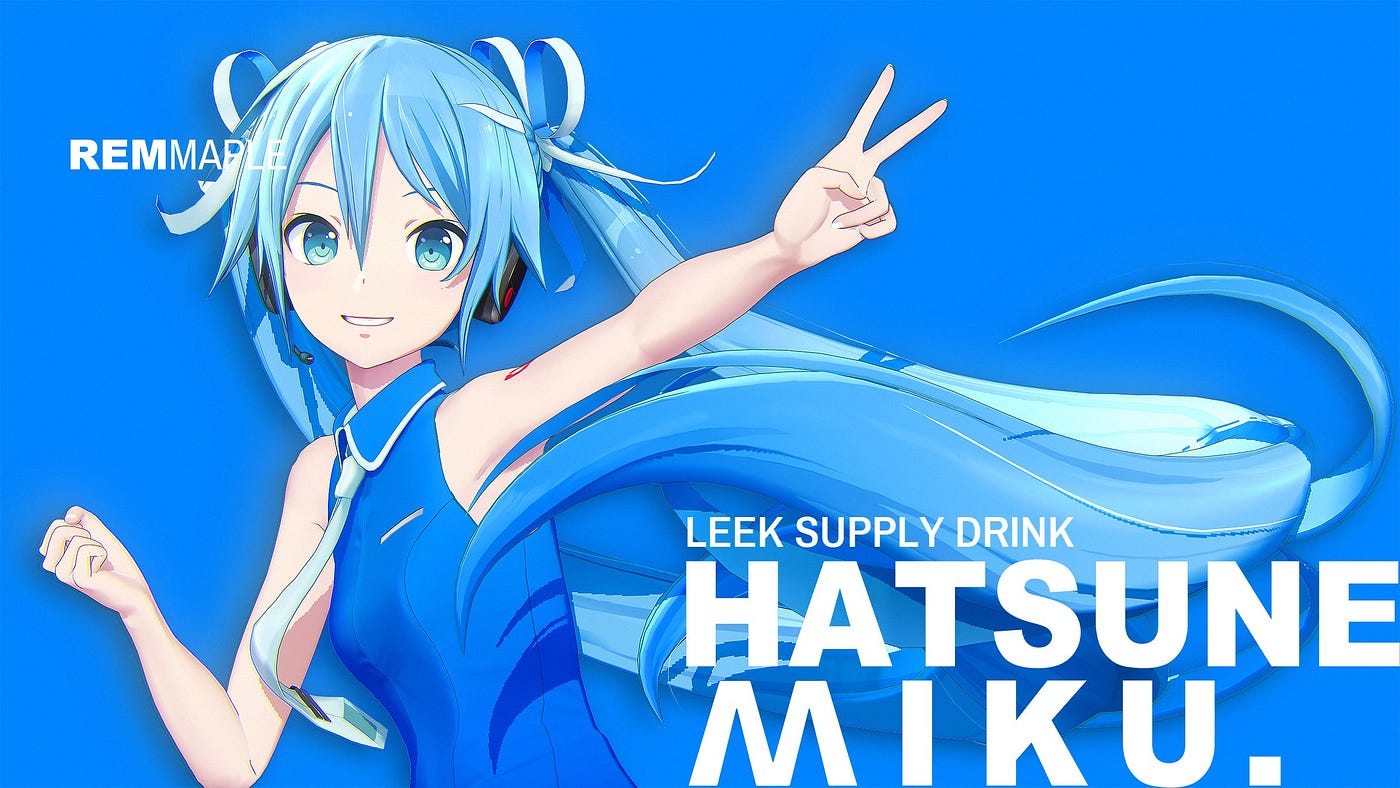
MikuMikuDance (MMD) 是 nijigen 行业领域内具有代表性的开源动画软件项目。它不仅限于初音未来IP。在MMD的推动下,一个蓬勃发展的、全面的业余动画制作生态系统已经出现。这个“创客生态系统”拥有强大的贡献者链,包括免费在线分享其 MMD 模型的志愿者建模者。(附图:社区建模者分享的免费Miku MMD模型:https://x.com/REMmaple/status/1718689283828031495)。
Compared to typical tech-elites, tech-otakus are less susceptible to being corrupted by capitalist interests because they are inherently equipped with a political agenda that transcends capitalism — a futuristic post-human use value, an affection for the “mechanical bride.” They produce and create out of love and for love. Even under technopoly, while there is a possibility of otaku becoming “enchanted” with their mechanical brides (e.g., the fetishism of post-bishoujo), tech otakus are masters of technology and will not become its slaves. When technopoly begin to hinder the iteration of their mechanical brides, they will resolutely break the shackles of such monopolies. Moreover, they have the ability to personally create and improve their mechanical brides, avoiding the pitfalls of sexual anxiety. Even if the otaku community’s sexual orientation towards fictional characters is fragmented, technology serves as a common language that unites them against the technological tyranny of large corporations. The appearance of the “mechanical bride” may vary, but the underlying technological structure is often the same.
与典型的科技精英相比,科技宅男不太容易被资本主义利益所腐蚀,因为他们天生就拥有超越资本主义的政治议程——一种未来主义的后人类使用价值,一种对“机械新娘”的喜爱。他们出于爱和为爱而生产和创造。即使在技术垄断下,虽然御宅族有可能对他们的机械新娘“着迷”(例如,后美少女的恋物癖),但技术宅男是技术的主人,不会成为它的奴隶。当技术垄断开始阻碍他们的机械新娘的迭代时,他们将坚决打破这种垄断的桎梏。此外,他们有能力亲自创造和改善他们的机械新娘,避免性焦虑的陷阱。即使宅男社区对虚构人物的性取向是支离破碎的,技术也是一种共同语言,将他们团结起来对抗大公司的技术暴政。“机械新娘”的外表可能会有所不同,但底层的技术结构往往是相同的。
It is undeniable that miHoYo’s products primarily sell “love” — the interactive romance experience with the mechanical bride — which largely exploits the sexual anxieties of otaku. However, the very founders of miHoYo were among the first of consumer otakus to break free from this trap. The only way for otaku to counter the prevalent technopoly in the current nijigen media environment is to become digital makers like those at miHoYo, using the miHoYo way to defeat the miHoYo. The maker’s craft is the key to the freedom of otaku, serving as their completion. The design governance of the nijigen does not conclude with the establishment of a miHoYo that generates positive externalities for society at large; a better future society requires more otaku to complete themselves through creation and innovation, act as makers, and establish countless “miHoYos.” These million miHoYos will drive the evolution of the nijigen media environment towards more advanced technological forms, possibly even leading to a fully automated communist society. As Wiener predicted:
不可否认,米哈游的产品主要销售“爱”——与机械新娘的互动浪漫体验——这在很大程度上利用了宅男的性焦虑。然而,miHoYo 的创始人是最早摆脱这个陷阱的消费者宅男之一。宅男在当前nijigen媒体环境中对抗普遍存在的技术垄断的唯一方法是成为像miHoYo那样的数字制造商,使用miHoYo的方式击败miHoYo。制造者的手艺是御宅族自由的关键,是御宅族的完成。nijigen的设计治理并不以建立一个为整个社会产生正外部性的miHoYo而告终;一个更美好的未来社会,需要更多的御宅族通过创造和创新来完善自己,充当制造者,建立无数的“miHoYos”。这百万米哈游将推动nijigen媒体环境向更先进的技术形式演变,甚至可能导致一个完全自动化的共产主义社会。正如维纳所预测的那样:
The messages between man and machine, machine and man, and machine and machine will inevitably become increasingly important in society.[35]
人与机器、机器与人、机器与机器之间的信息,在社会中将不可避免地变得越来越重要。[35]
At that time, there will no longer be distinct categories of otaku and nijigen, as human-machine relationships will have become a core aspect of human society. “Human-machine love” will be recognized as a genuine and normal social relationship, and the “mechanical bride” will have a life and soul of her own. Tech otakus are the heart of nijigen design governance, driven by love to propel the technological evolution of the nijigen media environment towards a future of human-machine symbiosis. By returning to their roles as digital makers, otaku can “save themselves” in the process of “saving the world,” thus achieving self-governance of otakus.
届时,宅男和二元将不再有明显的类别,因为人机关系将成为人类社会的核心方面。“人机之爱”将被公认为一种真实而正常的社会关系,“机械新娘”将拥有自己的生命和灵魂。科技宅男是nijigen设计治理的核心,在爱的驱使下,推动nijigen媒体环境的技术发展,走向人机共生的未来。通过回归数字制造者的角色,御宅族可以在“拯救世界”的过程中“拯救自己”,从而实现御宅族的自治。
Reference 参考
[1][4] Cao Lingjuan, Wang Ke. Using Technological Innovation to Create a Better Future (用技术创新创造美好未来) [N]. People’s Daily, 2023–11–20(014).
[1][4] 曹灵娟, 王珂.用技术创新创造美好未来 [N].人民日报, 2023–11–20(014).
[2] Marshall McLuhan. The Gutenberg Galaxy: The Making of Typographic Man [M]. Translated by Yang Chenguang. Beijing: Beijing Institute of Technology Press, 2014: 57.
[2] 马歇尔·麦克卢汉。古腾堡星系:印刷人的形成 [M].杨晨光译.北京: 北京理工大学出版社, 2014: 57.
[3] Robert Putnam. Bowling Alone: The Collapse and Revival of American Community [M]. Translated by Liu Bo, Zhu Naijuan, Zhang Ziyi, et al. Beijing: Peking University Press, 2011: 265–267.
[3] 罗伯特·普特南。独自打保龄球:美国社区的崩溃与复兴 [M].刘波、朱乃娟、章子怡等译,北京: 北京大学出版社, 2011: 265–267.
[5] Neil Postman. Amusing Ourselves to Death: Public Discourse in the Age of Show Business / The Disappearance of Childhood [M]. Translated by Zhang Yan, Wu Yanlian. Guilin: Guangxi Normal University Press, 2009: 4.
[5] 尼尔·波斯特曼。自娱自乐至死:演艺时代的公共话语/童年的消失[M].张彦、吴艳莲译.桂林: 广西师范大学出版社, 2009: 4.
[6] Zou Qichang. The “Heritage” in Traditional Classics: The Culture of Female Artisans in the System of “Zhou Li” (传统经典中的“遗产” — — 《周礼》体系中的女性工匠文化) [J]. Heritage, 2019, (01): 255–267+326.
[6]邹其昌.传统经典中的“遗产”:周传统经典中的“遗产”—《周礼》体系中的女性工匠文化[J].遗产, 2019, (01): 255–267+326.
[7] Akio Nakamori. ‘Otaku’ Research (1): The Streets Are Full of ‘Otaku’ (『おたく』の研究(1):街には『おたく』がいっぱい) [J/OL]. Manga Burikko, 1986, (06). [2023–12–12]. http://www.burikko.net/people/otaku01.html
[7] 中森昭夫. “宅男”研究 (1):街道上到处都是“宅男”(“宅男”研究 (1):街道上到处都是“宅男”[J/OL]。 漫画 Burikko, 1986, (06). [2023–12–12]. http://www.burikko.net/people/otaku01.html
[8] Eiji Otsuka. The History of ‘Otaku’ Spirit: The 1980s Theory (“御宅族”的精神史:1980 年代论) [M]. Translated by Zhou Yiliang. Beijing: Peking University Press, 2015: 160.
[8] 大冢英二.The History of '御宅族' Spirit: The 1980s Theory (“御宅族”的精神史:1980 年代论)周一良译。北京: 北京大学出版社, 2015: 160.
[9] Toru Honda. The Moe Man (萌える男) [M]. Tokyo: Chikuma Shobo, 2005.
[9] 本田彻.Thi Mo Man (萌える男) [m].东京:千曲尸体,2005 年。
[10][11][12] Marshall McLuhan. The Mechanical Bride: Folklore of Industrial Man [M]. Translated by He Daokuan. Beijing: Renmin University of China Press, 2004: 187, 179, 191.
[10][11][12] 马歇尔·麦克卢汉。机械新娘:工业人的民间传说[M].何道宽译。北京: 中国人民大学出版社, 2004: 187, 179, 191.
[13] Galbraith P. W. Otaku and the Struggle for Imagination in Japan [M]. Durham: Duke University Press, 2019: 91, 102.
[13] 加尔布雷思 P. W. 宅男与日本的想象力斗争 [M].达勒姆: 杜克大学出版社, 2019: 91, 102.
[14] Lieberman D. Z., Long M. E. The Molecule of More: How a Single Chemical in Your Brain Drives Love, Sex, and Creativity and Will Determine the Fate of the Human Race [M]. Dallas: BenBella Books, 2018.
[14] 利伯曼 D. Z., Long M. E.更多分子:大脑中的单一化学物质如何驱动爱情、性和创造力,并将决定人类的命运 [M].达拉斯:BenBella Books,2018 年。
[15] Hiroki Azuma. Otaku: Japan’s Database Animals (动物化的后现代 : 御宅族如何影响日本社会) [M]. Translated by Chu Xuan. Taipei: Dakang Arts Co., Ltd., 2012.
[15] 弘树。Otaku: Japan's Database Animals (动物化的后现代 : 御宅族如何影响日本社会) [M].楚轩译。台北: 大康艺术有限公司, 2012.
[16] Neil Postman. Technopoly: The Surrender of Culture to Technology [M]. Translated by He Daokuan. Beijing: Peking University Press, 2007.
[16] 尼尔·波斯特曼。技术垄断:文化向技术的投降[M].何道宽译。北京: 北京大学出版社, 2007.
[17][25] Zou Qichang, Chen Zhengyang. miHoYo, Technological Innovation, and the End of Otaku: A Study of Two-Dimensional Design Governance from the Perspective of Media Ecology (米哈游、技术创新与御宅族的终结 — — 媒介环境论视野下的二次元设计治理研究) [C]// The 12th International Academic Symposium on ACG Culture and Technology and Bahamut Paper Award. 2023.
[17][25]邹其昌, 陈正阳.miHo游、技术创新与御宅族的终结 — — — 媒介环境论视野下的二次元设计治理研究 [C]// 第12届ACG文化与技术国际学术研讨会暨巴哈姆特论文奖。2023.
[18] Wikipedia. Rance [DB/OL]. (2023–04–28) [2023–12–13]. https://ja.wikipedia.org/wiki/Rance.
[18] 维基百科。兰斯 [DB/OL]。(2023–04–28)[2023–12–13].https://ja.wikipedia.org/wiki/Rance。
[19] Craig C. Genshin Impact Generates $3.7 Billion on Mobile in First Two Years [EB/OL]. (2021–09–01) [2023–12–13]. https://sensortower.com/blog/genshin-impact-mobile-two-years-analysis.
[19] Craig C. Genshin Impact 在前两年在移动端创造了 37 亿美元的收入 [EB/OL]。(2021–09–01)[2023–12–13].https://sensortower.com/blog/genshin-impact-mobile-two-years-analysis。
[20] ActivePlayer. Genshin Impact Live Player Count and Statistics [EB/OL]. (2023–12–11) [2023–12–13]. https://activeplayer.io/genshin-impact/.
[20] 活跃玩家。Genshin Impact 实时玩家人数和统计数据 [EB/OL]。(2023–12–11)[2023–12–13].https://activeplayer.io/genshin-impact/。
[21] Masahiro Morioka. The Way Out of Perversion: The Mind and Cure of ‘Asexual’ Men (走出变态之路:“性无感”男人的心魔与心药) [M]. Translated by Chen Zhengyang. New Taipei: Bo Shi Cao Tang, 2023.
[21] 盛冈正弘.The Way Out of Perversion: The Mind and Cure of 'Asexual' Men (走出之路:“性无感”男人的心魔与心药) [M].陈正阳译.新台北:Bo Shi Cao Tang,2023 年。
[22] Tunehiro Uno. Maternal Dystopia (母性のディストピア) [M]. Tokyo: Shueisha, 2017.
[22] 宇野调宏. 母性反乌托邦(母性反乌托邦)[M]. 东京:集英社,2017 年。
[23][24] Innojoy. Innojoy Patent Search Engine [DB/OL]. (2023–12–13) [2023–12–13]. http://www.innojoy.com/search/home.html
[23][24] 英诺乔伊.Innojoy 专利搜索引擎 [DB/OL].(2023–12–13)[2023–12–13].http://www.innojoy.com/search/home.html
[26] Dooley B., Mozur P. Beating Japan at Its Own (Video) Game: A Smash Hit From China [EB/OL]. (2023–12–11) [2023–12–13]. https://www.nytimes.com/2022/03/16/business/genshin-impact-china-japan.html
[26] Dooley B., Mozur P. Beating Japan at Its Own (video) Game: A Smash Hit from China [EB/OL].(2023–12–11)[2023–12–13].https://www.nytimes.com/2022/03/16/business/genshin-impact-china-japan.html
[27] miHoYo. miHoYo Handbook [EB/OL]. (2023–05–29) [2023–12–13]. https://zhuanlan.zhihu.com/p/632945898.
[27] 米哈游.米哈游手册 [ab/ol].(2023–05–29)[2023–12–13]।httpps://juanlan.jihu.com/p/632945898。
[28] Williams A., Srnicek N. Accelerate: Manifesto for an Accelerationist Politics [M]// Mackay R., Avanessian A. #Accelerate: The Accelerationist Reader. Falmouth: Urbanomic, 2014: 354.
[28] Williams A., Srnicek N. 加速:加速主义政治宣言 [M]// Mackay R., Avanessian A. #Accelerate:加速主义读者。法尔茅斯:城市学,2014:354。
[29] Bastani A. Fully Automated Luxury Communism: A Manifesto [M]. London: Verso, 2019: 50.
[29] Bastani A. 全自动奢侈共产主义:宣言 [M].伦敦: Verso, 2019: 50.
[30] Lan Jiang. Left Accelerationism and Its Flaws: Why Accelerationism Cannot Replace Capitalism? (左翼加速主义及其缺憾 — — 为什么加速主义不可能替代资本主义?) [J]. Yuejiang Journal, 2023, 15(3): 25–34.
[30] 兰江.左翼加速主义及其缺陷:为什么加速主义不能取代资本主义?(左翼加速主义及其缺憾 — — 为什么加速主义不可能替代资本主义?)月江学报, 2023, 15(3): 25–34.
[31] Zou Qichang. On Artisan Culture and High-Quality Human Development (论工匠文化与人的高质量发展) [J]. Hubei Social Sciences, 2023, (09): 80–93.
[31]邹启昌.论工匠文化与人的高质量发展[J].湖北社会科学,2023,(09):80–93.
[32] Collected Works of Marx and Engels, Volume 3 (马克思恩格斯文集 第3卷) [M]. Beijing: People’s Publishing House, 2009: 435.
[32] Collected Works of Marx and Engels, Volume 3 (马克思恩格斯文集 第3卷) [M].北京: 人民出版社, 2009: 435.
[33] Collected Works of Marx and Engels, Volume 2 (马克思恩格斯文集 第2卷) [M]. Beijing: People’s Publishing House, 2009: 53.
[33] Collected Works of Marx and Engels, Volume 2 (马克思恩格斯文集 第2卷) [M].北京: 人民出版社, 2009: 53.
[34] Eric S. Raymond. The Cathedral and the Bazaar [M]. Translated by Wei Jianfan. Beijing: China Machine Press, 2014.
[34] 埃里克·雷蒙德。大教堂和集市 [M].魏建凡译.北京: 机械工业出版社, 2014.
[35] Norbert Wiener. The Human Use of Human Beings: Cybernetics and Society[M]. Translated by Chen Bu. Beijing: Peking University Press, 2010: 12.
[35] 诺伯特·维纳。人类对人类的利用:控制论与社会[M].陈布译. 北京: 北京大学出版社, 2010: 12.
